A Natural GMS Laboratory (Granulometry-Morphometry-Situmetry): Geomorphological-Sedimentological-Mineralogical Terrain Analysis Linked to Coarse-Grained Siliciclastic Sediments at the Basement-Foreland Boundary (SE Germany)
Abstract
:1. Introduction
- How can the GMS triplet be subdivided, applied and linked up with other geoscience operatives under near-ambient conditions and in which theater of operation can each of them most favorably be used?
- How and where in applied and genetic geomorphology and sedimentology can the GMS tool successfully be used to tackle environment and provenance analyses?
- Which are the main goals of each element, granulometry, morphometry and situmetry, and how can they be achieved?
- To define new numerical parameters for each sub-tool to achieve the established goals on a field and laboratory scale.
2. Methodology
2.1. Field Work
2.2. Laboratory Work
2.3. Mineralogy and Petrology
2.4. Geochemistry
2.5. Geomorphology
3. Geological Setting
4. Results
4.1. Geomorphology of the Steinach Drainage System
4.2. Lithology of the Gravel-Sized Fluvial and Colluvial Deposits
4.3. Grain Morphology of the Gravelly Debris
4.3.1. 2-D Visual Examination and Comparison Charts
4.3.2. 3-D Measurement of Shape and the Morphology Indices
4.3.3. Digital Image Analysis
4.4. Granulometry of the Gravelly Debris
4.5. Situmetry of the Gravelly Debris
5. Discussion
5.1. The Natural Processing Plant—Compartmentalization and Grain Size Distribution
5.2. Provenance Marker and Grain Morphology Distribution
5.3. Hydrodynamic Facies Analysis and the Orientation of Clasts
5.3.1. Clast Orientation in Plain View
5.3.2. Clast Orientation in Cross or Longitudinal Sections
5.4. Synopsis and Outlook
6. Conclusions
Author Contributions
Funding
Data Availability Statement
Acknowledgments
Conflicts of Interest
References
- Wilson, J.L. Carbonate Facies in Geologic Time; Springer: New York, NY, USA, 1975; p. 471. [Google Scholar]
- Reading, H.G. Sedimentary Environments and Facies; Elsevier: Amsterdam, The Netherlands, 1978; p. 557. [Google Scholar]
- Tucker, M.E.; Wright, V.P. Carbonate Sedimentology; Blackwell: Oxford, UK, 1990; 482p. [Google Scholar]
- Galloway, W.E.; Hobday, D.K. Terrigenous Clastic Depositional Systems—Applications to Fossil Fuel and Groundwater Resources Rocks; Springer: Berlin/Heidelberg, Germany, 1996; p. 489. [Google Scholar]
- Scholle, P.A.; Ulmer-Scholle, D.S. A Color Guide to the Petrography of Carbonate Rocks. AAPG Mem. 2003, 77, 474. [Google Scholar]
- Jensen, S. Paleontology: Reading Behavior from the Rocks. Science 2008, 322, 1051–1052. [Google Scholar] [CrossRef]
- Flügel, E. Microfacies of Carbonate Rocks-Analysis, Interpretation and Application, 2nd ed.; Springer: Berlin/Heidelberg, Germany, 2009; p. 984. [Google Scholar]
- MacEachern, J.; Pemberon, S.G.; Gingras, M.K.; Bann, K.L. Ichnology and Facies Models. In Facies Models 4; James, N., Dalrymple, R.W., Eds.; SEPM: Broken Arrow, OK, USA, 2010; pp. 19–58. [Google Scholar]
- Reineck, H.E.; Singh, I.B. Depositional Sedimentary Environments: With Reference to Terrigenous Clastics; Springer Science Business Media: New York, NY, USA, 2012; p. 551. [Google Scholar]
- Prothero, D.R.; Schwab, F. Sedimentary Geology, 3rd ed.; W.H. Freeman: New York, NY, USA, 2014; p. 500. [Google Scholar]
- Krumbein, W.C. The probable error of sampling sediments for mechanical analysis. Amer. J. Sci. 1934, 27, 204–214. [Google Scholar] [CrossRef]
- Inman, D.L. Measures for describing the size distribution of sediments. J. Sed. Petr. 1952, 22, 125–145. [Google Scholar]
- Folk, R.L.; Ward, W.C. Brazos River bar: A study in the significance of grain size Parameters. J. Sed. Petr. 1958, 27, 3–26. [Google Scholar] [CrossRef]
- McCommon, R.B. Efficiencies of percentile measures for describing the mean size and sorting of sedimentary particles. J. Geol. 1962, 70, 453–465. [Google Scholar] [CrossRef]
- Passega, R.; Byramjee, R. Grain-size image of clastic deposits. Sedimentology 1969, 13, 233–252. [Google Scholar] [CrossRef]
- Visher, G.S. Grain-size distributions and depositional processes. J. Sediment. Petrol. 1969, 39, 1074–1106. [Google Scholar]
- Tucker, M.E. Sedimentary Rocks in the Field; John Wiley & Sons: Chichester, UK, 1996; p. 153. [Google Scholar]
- Bari, Z.; Rajib, M.; Majid, M.; Sayem, H. Textural analyses of the bar sands of the Gorai River: Implications for depositional phase and environment. Jahangirnagar Univ. Environ. Bull. 2012, 1, 25–34. [Google Scholar] [CrossRef]
- Liro, M. Differences in the reconstructions of the depositional environment of overbank sediments performed using the C/M diagram and cumulative curve analyses. Landf. Anal. 2015, 29, 35–40. [Google Scholar] [CrossRef]
- Warrier, A.K.; Pednekar, H.; Mahesh, B.S.; Mohan, R.; Gazi, S. Sediment grain size and surface textural observations of quartz grains in late Quaternary lacustrine sediments from Schirmacher Oasis, East Antarctica: Paleoenvironmental significance. Polar Sci. 2016, 10, 89–100. [Google Scholar] [CrossRef]
- Baiyegunhi, C.; Liu, K.; Gwavava, O. Grain size statistics and depositional pattern of the Ecca Group sandstones, Karoo Supergroup in the Eastern Cape Province, South Africa. Open Geosci. 2017, 9, 554–576. [Google Scholar] [CrossRef]
- Koning, D.J.; Jochems, A.P.; Morgan, G.S.; Lueth, V.W.; Peters, L. Stratigraphy, gravel provenance, and age of early Rio Grande deposits exposed 1–2 km northwest of downtown Truth or Consequences, New Mexico. Guidebook 67—Geology of the Belen Area. In New Mexico Geological Society 67th Annual Fall Field Conference Guidebook; Frey, B.A., Karlstrom, K.E., Lucas, S.G., Williams, S., Ziegler, K., McLemore, V., Ulmer-Scholle, D.S., Eds.; Albuquerque Geological Society of New Mexico: Socorro, NM, USA, 2016; pp. 459–478. [Google Scholar]
- Powers, M.C. Comparison Chart for Estimating Roundness and Sphericity. Amer. Geol. Inst. Data Sheet 1982, 18, 1. [Google Scholar]
- Illenberger, W. Pebble shape (and size!). J. Sediment. Petrol. 1991, 61, 756–767. [Google Scholar]
- Nelson, F.E. A preliminary investigation of solifluction macrofabrics. Catena 1985, 12, 23–33. [Google Scholar] [CrossRef] [Green Version]
- Francou, B. Stratification mechanisms in slope deposits in high subequatorial mountains. Permafr. Periglac. Process. 1990, 1, 249–263. [Google Scholar] [CrossRef]
- Nieuwenhuijzen, M.E.; Van Steijn, H. Alpine debris flows and their sedimentary properties. A Case Study Fr. Alps. Permafr. Periglac. Process. 1990, 1, 111–128. [Google Scholar] [CrossRef]
- Mills, H.H. Three-dimensional clast orientation in glacial and mass-movement sediments: A compilation and preliminary analysis. US Geol. Surv. Open File Rep. 1991, 90–128, 1–71. [Google Scholar]
- Millar, S.W.; Nelson, F.E. Sampling-surface orientation and clast macrofabric in periglacial colluviums. Earth Surf. Process. Landf. Earth Surf. Process. Landf. 2001, 26, 523–529. [Google Scholar] [CrossRef]
- Wentworth, C.K. A scale of grade and class terms for clastic sediments. J. Geol. 1922, 30, 377–392. [Google Scholar] [CrossRef]
- Thauer, W. Morphologische Studien im Frankenwald und im Frankenwaldvorland. Mitt. Der Fränkischen Geogr. Ges. 1954, 1, 1–232. [Google Scholar]
- Emmert, U.; Weinelt, W. Geologische Karte von Bayern 1:25,000 Erläuterung Blatt 5935 Marktschorgast; Geologisches Landesamt: München, Germany, 1962; p. 286. [Google Scholar]
- Stettner, G. Geologische Karte von Bayern 1:25,000 Erläuterung Blatt 5936 Bad Berneck; Geologisches Landesamt: München, Germay, 1977; p. 225. [Google Scholar]
- Drexler, O. Das Espich-Sediment bei Kulmbach. Bayreuther Geowiss. Arb. 1980, 1, 9–38. [Google Scholar]
- Emmert, U.; Stettner, G. Geologische Karte von Bayern 1:25,000 Erläuterung Blatt 6036 Weidenberg; Geologisches Landesamt: München, Germany, 1995; p. 239. [Google Scholar]
- Peterek, A. Zur geomorphologischen und morpho-tektonischen Entwicklung des Fichtelgebirges und seines unmittelbaren Rahmens. Geol. Bl. NO-Bayern 2001, 51, 37–106. [Google Scholar]
- Schirmer, W. Taleintiefung in der Nördlichen Frankenalb in den letzten 200,000 Jahren. Geol. Blätter Nord. -Bayern 2010, 60, 229–250. [Google Scholar]
- Schirmer, W. Die Geschichte von Moenodanuvius und Main in Oberfranken. In Streifzüge durch Franken Band; Dippold, G., Ed.; Lichtenfels: Lichtenfels, Germany, 2010; Volume 1, pp. 9–24. [Google Scholar]
- Schirmer, W. Geröllverwitterung der Main-Formation. Geol. Blätter Nord. Bayern 2012, 62, 181–208. [Google Scholar]
- Zöller, L.; Stingl, H.; Kleber, A. Das Trebgasttal—Tal- und Landschaftsentwicklung nahe der Europäischen Hauptwasserscheide im Raum Bayreuth. Bayreuther Geogr. Arb. 2007, 28, 70–101. [Google Scholar]
- Dill, H.G.; Buzatu, A.; Balaban, S.-I.; Ufer, K.; Techmer, A.; Schedlinsky, W.; Füssl, M. The transition of very coarse-grained meandering to straight fluvial drainage systems in a tectonized foreland-basement landscape during the Holocene (SE Germany)—A joint geomorphological-geological study. Geomorphology 2020, 370, 107364. [Google Scholar] [CrossRef]
- Dill, H.G.; Buzatu, A.; Balaban, S.-I. Straight to low-low sinuosity drainage systems in a Variscan-Type Orogen—Constraints from tectonics, lithology and climate. Minerals 2021, 11, 933. [Google Scholar] [CrossRef]
- Udden, J.A. Mechanical composition of clastic sediments. Geol. Soc. Am. Bulletin. 1914, 25, 655–744. [Google Scholar] [CrossRef]
- Friedman, G.M.; Sanders, J.E.; Kopaska-Merkel, D.C. Principles of Sedimentary Deposits; MacMillan Publishing Company: New York, NY, USA, 1992; p. 717. [Google Scholar]
- Johansson, C.E. Orientation of pebbles in running water. A Lab. Study. Geogr. Ann. 1963, 45, 85–112. [Google Scholar]
- Johansson, C.E. Structural studies of sedimentary deposits. Orientation analyses, literature digest and field investigation. Geol. Föreningens Förhandlingar 1965, 87, 3–61. [Google Scholar] [CrossRef]
- Owczarek, P. The variation in clasts orientation in mid-mountain river channels under the influence of coarse-grained regolith supply, Polish Flysch Carpathians. Studia Geomorphol. Carpato Balc. 2003, 37, 97–110. [Google Scholar]
- Edwards, A.C. Grain size and sorting in modern beach sands. J. Coast. Res. 2001, 17, 38–52. [Google Scholar]
- Nichols, G. Sedimentology and Stratigraphy; Blackwell Publication: Oxford, UK, 2009; p. 432. [Google Scholar]
- Callahan, J. A nontoxic heavy liquid and inexpensive filters for separation of minerals grains. J. Sediment. Petrol. 1987, 57, 765–766. [Google Scholar] [CrossRef]
- McCann, T. The Geology of Central Europe: Precambrian and Paleozoic: 1; The Geological Society of London: London, UK, 2008; p. 748. [Google Scholar]
- McCann, T. The Geology of Central Europe: Mesozoic and Cenozoic: 2; The Geological Society of London: London, UK, 2008; p. 700. [Google Scholar]
- Dill, H.G.; Hansen, B.; Keck, E.; Weber, B. Cryptomelane a tool to determine the age and the physical-chemical regime of a Plio-Pleistocene weathering zone in a granitic terrain (Hagendorf, SE Germany). Geomorphology 2010, 121, 370–377. [Google Scholar] [CrossRef]
- Knight, D.W.; Brown, F.A.; Valentine, E.; Nalluri, C.; Bathurst, J.; Benson, I.; Myers, R.; Lyness, J. Cassells. J. The response of straight mobile bed channels to inbank and overbank flows. Proc. Inst. Civ. Eng. Water Marit. Energy 1999, 136, 211–224. [Google Scholar] [CrossRef]
- Rodriguez, J.F.; Garcia, M.H. Laboratory measurements of 3-D flow patterns and turbulence in straight open channel with rough bed. J. Hydraul. Research. 2008, 46, 454–465. [Google Scholar] [CrossRef]
- Scheffers, A.M.; May, S.M.; Kelletat, D.H. Forms by Flowing Water (Fluvial Features). In Landforms of the World with Google Earth; Springer: Amsterdam, The Netherlands, 2015; pp. 183–244. [Google Scholar]
- Twidale, C.R.; Vital-Romani, J.R. Landforms and Geology of the Granite Terrains; Balkema: Leiden, The Netherlands, 2005; p. 344. [Google Scholar]
- Migoń, P. Granite Landscapes of the World. Geomorphological Landscapes of the World 22; Oxford University Press: Oxford, UK, 2006; p. 416. [Google Scholar]
- Mandl, G. Rock Joints: The Mechanical Genesis; Springer: Berlin/Heidelberg, Germany, 2005; p. 221. [Google Scholar]
- Migon, P.; Thomas, M.F. Grus weathering mantles—problems of interpretation. Catena, 2002; 49, 5–24. [Google Scholar]
- Hayakawa, Y.S.; Matsukura, Y. Factors influencing the recession rate of Niagara Falls since the 19th century. Geomorphology 2009, 110, 212–216. [Google Scholar] [CrossRef]
- Royden, L.H.; Perron, J.T. Solutions of the stream power equation and application to the evolution of river longitudinal profiles. J. Geophys. Res. Earth Surf. 2013, 118, 497–518. [Google Scholar] [CrossRef]
- Vannucchi, P. Scaly fabric and slip within fault zones. Geosphere 2019, 15, 342–356. [Google Scholar] [CrossRef]
- Nanson, G.C.; Knighton, A.D. Anabranching rivers: Their cause, character and classification. Earth Surf. Process. Landf. 1996, 21, 217–239. [Google Scholar] [CrossRef]
- Church, M. Geomorphic thresholds in riverine landscapes. Freshw. Biol. 2002, 47, 541–557. [Google Scholar] [CrossRef]
- Beechie, T.J.; Liermann, M.; Pollock, M.M.; Baker, S.; Davies, J. Channel pattern and river-floodplain dynamics in forested mountain river systems. Geomorphology 2006, 78, 124–141. [Google Scholar] [CrossRef]
- Charlton, R. Fundamentals of Fluvial Geomorphology; Routledge: Abingdon, UK, 2014; 214p. [Google Scholar]
- Ahnert, F.O. Einführung in die Geomorphologie; UTB GmbH: Stuttgart, Germany, 2015; p. 458. [Google Scholar]
- Hornung, J.; Aigner, T. Reservoir architecture in a terminal alluvial plain: An outcrop analogue study (Upper Triassic, Southern Germany Part I, Sedimentology and petrophysics. J. Pet. Geol. 2002, 25, 3–30. [Google Scholar] [CrossRef]
- Reinhard, L.; Ricken, W. Climate cycles documented in a playa system: Comparison of geochemical signatures derived from subbasins (Triassic, Middle Keuper, German Basin). In West European Case Studies in Stratigraphy. Zentralblatt für Geologie und Paläontologie part I; Bock, H., Müller, R., Swennen, R., Zimmerle, W., Eds.; Schweizerbart Science Publishers: Stuttgart, Germany, 2000; pp. 315–340. [Google Scholar]
- Dill, H.G. Zur Geologie und Mineralogie der Schwerspatvorkommen in Bayern. Mit einem Beitrag zum Strontiumvorkommen bei Stadtsteinach/Frankenwald. Geol. Jahrb. D 1983, 61, 93–145. [Google Scholar]
- Verplanck, P.L.; Yager, D.B.; Church, S.E.; Stanton, M.R. Ferricrete Classification, Morphology, Distribution, and Carbon-14 Age Constraints; Professional Paper of the US. Geological Survey 1651; U.S. Department of the Interior: Reston, VA, USA, 2007. [Google Scholar]
- Dill, H.G.; Weber, B.; Botz, R. Metalliferous duricrusts (“orecretes”)—Markers of weathering: A mineralogical and climatic-geomorphological approach to supergene Pb-Zn- Cu-Sb-P mineralization on different parent materials. Neues Jahrb. Mineral. Abh. 2013, 190, 123–195. [Google Scholar] [CrossRef]
- Dill, H.G.; Ludwig, R.-R. Geomorphological-sedimentological studies of landform types and modern placer deposits in the savanna (Southern Malawi). Ore Geol. Rev. 2008, 33, 411–434. [Google Scholar] [CrossRef]
- Dill, H.G.; Techmer, A.; Weber, B.; Fuessl, M. Mineralogical and chemical distribution patterns of placers and ferricretes in Quaternary sediments in SE Germany: The impact of nature and man on the unroofing of pegmatites. J. Geochem. Explor. 2008, 96, 1–24. [Google Scholar] [CrossRef]
- Summerfield, M.A. Silcretes. In Chemical Sediments and Their Geomorphology; Goudie, A.S., Pye, K., Eds.; Academic Press: London, UK, 1983; pp. 59–92. [Google Scholar]
- Summerfield, M.A. Silcrete as a palaeoclimatic indicator: Evidence from southern Africa. Palaeogeogr. Palaeoclimatol. Palaeoecol. 1983, 41, 65–79. [Google Scholar] [CrossRef]
- Nash, D.J.; Shaw, P.A. Silica and carbonate relationships in silcrete–calcretes intergrade duricrusts from the Kalahari desert of Botswana and Namibia. J. Afr. Earth Sci. 1998, 27, 11–25. [Google Scholar] [CrossRef]
- Ullyott, J.; Nash, D.; Whiteman, C.; Mortimore, R. Distribution, petrology, and mode of development of silcretes (sarsens and puddingstones) on the Eastern South Downs, UK. Earth Surf. Processes Landf. 2004, 29, 1509–1539. [Google Scholar] [CrossRef]
- Neuendorf, K.K.E.; Mehl, J.P., Jr.; Jackson, J.A.; Neuendorf, K.K.E. Glossary of Geology, 5th ed.; American Geological Institute: Alexandria, VA, USA, 2005; p. 779. [Google Scholar]
- Bucher, K.; Grapes, R. Petrogenesis of Metamorphic Rocks; Springer: Berlin/Heidelberg, Germany; Dortrecht, The Netherland; London, UK; New York, NY, USA, 2011; p. 428. [Google Scholar]
- Robertson, S. BGS Rock classification scheme—Classification of metamorphic rocks. Br. Geol. Surv. Res. Rep. 1999, 99, 24. [Google Scholar]
- Richter, L.; Diamond, L.W. Characterization of hydrothermal fluids that alter the upper oceanic crust to spilite and epidosite: Fluid inclusion evidence from the Semail (Oman) and Troodos (Cyprus) ophiolites. Geochim. Cosmochim. Acta 2022, 319, 220–253. [Google Scholar] [CrossRef]
- Dill, H.G.; Techmer, A.; Kus, J. Evolution of an old mining district between 725 and 1630 AD at the boundary between Thüringen and Bayern, SE Germany, using mineralogical and chemical markers, radio-carbon dating and coal petrography of slags. Archaeol. Anthropol. Sci. 2013, 5, 215–233. [Google Scholar] [CrossRef]
- Powers, M.C. A new roundness scale for sedimentary particles. J. Sediment. Petrol. 1953, 23, 117–119. [Google Scholar]
- Boggs, S., Jr. Principles of Sedimentology and Stratigraphy; Prentice Hall: New York, NY, USA, 2011; p. 600. [Google Scholar]
- Barudžija, U.; Velic, J.; Malvic, T.; Trenc, N.; Matovinovic Božinovic, N. Morphometric characteristics, shapes and provenance of Holocene pebbles from the Sava River gravels (Zagreb, Croatia). Geosciences 2020, 10, 92. [Google Scholar] [CrossRef]
- Zingg, T. Beitrag zur Schotteranalyse. Schweiz. Mineral. Petrogr. Mitt. 1935, 15, 39–140. [Google Scholar]
- Blott, S.; Pye, K. Particle shape: A review and new methods of characterization and classification. Sedimentology 2007, 55, 31–63. [Google Scholar] [CrossRef]
- Xie, W.-Q.; Zhang, X.-P.; Yang, X.-M.; Liu, Q.-S.; Tang, S.-H.; Tuc, X.-B. 3D size and shape characterization of natural sand particles using 2D image analysis. Eng. Geol. 2020, 279, 105915. [Google Scholar] [CrossRef]
- Beemer, R.D.; Li, L.; Leonti, A.; Shaw, J.; Fonseca, J.; Valova, I.; Iskander, M.; Pilskaln, C.H. Comparison of 2D optical imaging and 3D microtomography shape measurements of a coastal bioclastic calcareous sand. J. Imaging 2022, 8, 72. [Google Scholar] [CrossRef]
- Matsumoto, N.; Ogawa, M.; Takayasu, K.; Hirayama, M.; Miura, T.; Shiozawa, K.; Abe, M.; Nakagawara, H.; Moriyama, M.; Udagawa, S. Quantitative sonographic image analysis for hepatic nodules: A pilot study. J. Med Ultrason. 2015, 42, 505–512. [Google Scholar] [CrossRef]
- López G., I. Grain Size Analysis. In Encyclopedia of Geoarchaeology; Gilbert, A.S., Ed.; Springer: Berlin/Heidelberg, Germany, 2017; pp. 341–348. [Google Scholar]
- Blair, T.C.; McPherson, J.G. Grain-size and textural classification of coarse sedimentary particles. J. Sediment. Res. 1999, 69, 6–19. [Google Scholar] [CrossRef]
- Kamata, H.; Mimura, K. Flow directions inferred from imbrication in the Handa pyroclastic flow deposit in Japan. Bull. Volcanol. 1983, 46, 277–282. [Google Scholar] [CrossRef]
- Mills, H.H. Clast Orientation in Mount St. Helens Debris-Flow Deposits, North Fork Toutle River, Washington. J. Sediment. Petrol. 1984, 54, 626–634. [Google Scholar]
- Cenderelli, D.A.; Wohl, E.E. Sedimentology and clast orientation of deposits produced by glacial-lake outburst floods in the Mount Everest Region, Nepal. In Geomorphological Hazards in High Mountain Areas; Kalvoda, J., Rosenfeld, C.L., Eds.; The GeoJournal Library; Springer: Berlin/Heidelberg, Germany, 1998; Volume 46, pp. 1–26. [Google Scholar]
- Karatson, D.; Sztano, O.; Telbisz, T. Preferred clast orientation in volcaniclastic mass-flow deposits Application of a new photo-statistical method. J. Sediment. Res. 2002, 72, 823–835. [Google Scholar] [CrossRef]
- Cunningham, A.; Wilson, P. Relict periglacial boulder sheets and lobes on Slieve Donard, Mountains of Mourne, Northern Ireland. Ir. Geogr. 2004, 37, 187–201. [Google Scholar] [CrossRef]
- Lindsay, J.F. The development of clast fabric in mudflows. J. Sediment. Petrol. 1968, 38, 1242–1253. [Google Scholar]
- Rust, B.R. Pebble orientation in fluvial sediments. J. Sediment. Petrol. 1972, 42, 553–562. [Google Scholar]
- Babault, J.; Bonnet, S.; Driessche, J.V.D.; Crave, A. High elevation of low-relief surfaces in mountain belts: Does it equate to post-orogenic surface uplift? Terra Nova 2007, 19, 272–277. [Google Scholar] [CrossRef]
- Landis, C.A.; Campbell, H.J.; Begg, J.G.; Mildenhall, D.C.; Paterson, A.M.; Trewick, S.A. The Waipounamu erosion surface: Questioning the antiquity of the New Zealand land surface and terrestrial fauna and flora. Geol. Mag. 2008, 145, 173–197. [Google Scholar] [CrossRef]
- Hall, A.M.; Ebert, K.; Kleman, J.; Nesje, A.; Ottesen, D. Selective glacial erosion on the Norwegian passive margin. Geology 2013, 41, 1203–1206. [Google Scholar] [CrossRef]
- Crosby, B.T.; Whipple, K.X. Knickpoint initiation and distribution within fluvial networks: 236 waterfalls in the Waipaoa River, North Island, New Zealand. Geomorphology 2006, 82, 16–38. [Google Scholar] [CrossRef]
- Stanaway, K.J. Heavy mineral placers. Min. Eng. 1992, 44, 352–358. [Google Scholar]
- Dill, H.G. Heavy mineral response to the progradation of an alluvial fan: Implications concerning unroofing of source area, chemical weathering, and paleo-relief (Upper Cretaceous Parkstein fan complex / SE Germany). Sediment. Geol. 1995, 95, 39–56. [Google Scholar] [CrossRef]
- Vieira, M.G.; Albino, J.; Leal, A.; Bastos, A. Quartz grain assessment for reconstructing the coastal palaeoenvironment. J. S. Am. Earth Sci. 2016, 70, 353–367. [Google Scholar] [CrossRef]
- Zoleikhaei, Y.; Frei, D.; Morton, A.; Zamanzadeh, S. of heavy minerals (zircon and apatite) as a provenance tool for unravelling recycling: A case study from the Sefidrud and Sarbaz Rivers in N and SE Iran. Sediment. Geol. 2016, 342, 106–117. [Google Scholar] [CrossRef]
- Makuluni, P.; Kirkland, C.L.; Barham, M. Zircon grain shape holds provenance information: A case study from southwestern Australia. Geol. J. 2019, 54, 1279–1293. [Google Scholar] [CrossRef]
- Yue, W.; Yue, X.; Zhang, L.; Liu, X.; Song, J. Morphology of Detrital Zircon as a Fingerprint to Trace Sediment Provenance: Case Study of the Yangtze Delta. Minerals 2019, 9, 438. [Google Scholar] [CrossRef]
- Chen, G.; Dong, Z.; Li, C.; Shi, W.; Shao, T.; Nan, W.; Yang, J. Provenance of aeolian sediments in the Ordos Deserts and its Implication for weathering, sedimentary processes. Front. Earth Sci. 2021, 9, 711802. [Google Scholar] [CrossRef]
- Yan, L.; Zhenkui, J.; Ting, J.; Liang, S. Geological significance of magmatic gravel roundness. Acta Sedimentologica Sin. 2014, 32, 189–197. [Google Scholar]
- Tao, J.; Zhang, C.; Zhu, R. Gravel roundness quantitative analysis for sedimentary microfacies of fan delta deposition, Baikouquan Formation, Mahu Depression. Northwestern China Open Geosci. 2020, 12, 1630–1644. [Google Scholar] [CrossRef]
- Wang, J.; Pei, L.; Zhang, H.; Dembele, N. Morphology of gravels from the Yangluo Formation in the Southern Pediment of Dabie Mountains. Geol. China 2021, 48, 139–148. [Google Scholar] [CrossRef]
- Dahl, R. Block fields, weathering pits and tor-like forms in the Narvik Mountains, Nordland, Norway. Geogr. Ann. A 1966, 48, 55–85. [Google Scholar] [CrossRef]
- Dahl, E. The nunatak theory reconsidered. Ecol. Bull. 1987, 38, 77–94. [Google Scholar]
- Rea, B.R.; Whalley, W.B.; Rainey, M.M.; Gordon, J.E. Blockfields, old or new? Evidence and implications from some plateaus in northern Norway. Geomorphology 1996, 15, 109–121. [Google Scholar] [CrossRef]
- Ballantyne, C.K. A general model of autochthonous blockfield evolution. Permafr. Periglac. Process. 2010, 21, 289–300. [Google Scholar] [CrossRef]
- Popov, S.V.; Rögl, F.; Rozanov, A.Y.; Steininger, F.F.; Sherba, I.G.; Kovač, M. Lithological-paleogeographic maps of Paratethys. 10 maps Late Eocene to Pliocene. Cour. Forsch. Senckenberg 2005, 250, 1–46. [Google Scholar]
- Miall, A.D. The Geology of Fluvial Deposits: Sedimentary Petroleum Geology; Springer: Berlin/Heidelberg, Germany, 1996; Volume 582, p. 582. [Google Scholar]
- Starke, R. Verteilung und Faziesabhängigkeit der Tonminerale in dem geologischen System. Freib. Forsch. C 1970, 254, 1–185. [Google Scholar]
- Ludwig, V. Zum Übergang eines Tonschiefers in die Metamorphose:“Griffelschiefer” im Ordovizium von NE-Bayern. Neues Jb. Geol. Paläontol. Abh. 1973, 144, 50–103. [Google Scholar]
- Macurová, T.; Škarpich, V.; Galia, T. Effect of lithology and morphology of high-gradient channels on bed sediments: A case study of the Kobylská Stream (Vsetín highlands, Czech Republic) (Abstract in English). Geol. Ýzkumy Na Moravě Slez. 2018, 25. [Google Scholar] [CrossRef]
- Prior, D.J.; Knipe, R.J.; Bates, M.P.; Grant, N.T.; Law, R.D.; Lloyd, G.E.; Welbon, A.; Agar, S.M.; Brodie, K.H.; Maddock, R.H.; et al. Orientation of specimens: Essential data for all fields of geology. Geology 1987, 15, 829–831. [Google Scholar] [CrossRef]
- Hastings, J.O. Coarse-Grained Meander-Belt Reservoirs, Rocky Ridge Field, North Dakota. In Sandstone Petroleum Reservoirs. Casebooks in Earth Sciences; Barwis, J.H., McPherson, J.G., Studlick, J.R.J., Eds.; Springer: New York, NY, USA, 1990; pp. 57–84. [Google Scholar]
- Schlunegger, F.; Garefalakis, P. Clast imbrication in coarse-grained mountain streams and stratigraphic archives as indicator of deposition in upper flow regime conditions. Earth Surf. Dynam. 2018, 6, 743–761. [Google Scholar] [CrossRef]
- Puig, J.M.; Cabello, P.; Howell, J.; Arbués, P. Three-dimensional characterization of sedimentary heterogeneity and its impact on subsurface flow behavior through the braided-to-meandering fluvial deposits of the Castissent Formation (late Ypresian, Tremp-Graus Basin, Spain). Mar. Pet. Geol. 2019, 103, 661–680. [Google Scholar] [CrossRef]
- Nelson, K.J.P.; Nelson, F.E.; Walegur, M.T. Periglacial Appalachia: Palaeoclimatic significance of blockfield elevation gradients, eastern USA. Permafr. Periglac. Process. 2007, 18, 61–73. [Google Scholar] [CrossRef]
- Andre, M.F.; Hall, K.; Bertran, P.; Arocena, J. Stone runs in the Falkland Islands: Periglacial or tropical. Geomorphology 2008, 95, 524–543. [Google Scholar] [CrossRef]
- Dill, H.G. Grain morphology of heavy minerals from marine and continental placer deposits, with special reference to Fe -Ti oxides. Sediment. Geol. 2007, 198, 1–27. [Google Scholar] [CrossRef]
- James, D.E.; DeVaughn, A.M.; Marsaglia, K.M. Sand and Gravel Provenance in the Waipaoa River System: Sedimentary Recycling in an Actively Deforming Forearc Basin, North Island, New Zealand; Geological Society of America: Boulder, CO, USA, 2007. [Google Scholar] [CrossRef]
- Morton, A.; Chenery, S. Detrital rutile geochemistry and thermometry as guides to provenance of Jurassic Paleocene sandstones of the Norwegian Sea. J. Sediment. Res. 2009, 79, 540–553. [Google Scholar] [CrossRef] [Green Version]
- Dill, H.G.; Klosa, D. Heavy-mineral-based provenance analysis of Mesozoic continental-marine sediments at the western edge of the Bohemian Massif, SE Germany: With special reference to Fe-Ti minerals and the crystal morphology of heavy minerals. Int. J. Earth Sci. 2011, 100, 1497–1513. [Google Scholar] [CrossRef]
- Dill, H.G.; Weber, B.; Klosa, D. Crystal morphology and mineral chemistry of monazite–zircon mineral assemblages in continental placer deposits (SE Germany): Ore guide and provenance marker. J. Geochem. Explor. 2012, 112, 322–346. [Google Scholar] [CrossRef]
- McClenaghan, M.B.; Paulen, R.C. Application of Till Mineralogy and Geochemistry to Mineral Exploration, 2nd ed.; Menzies, J., van der Meer, J.J.M., Eds.; Past Glacial Environments; Elsevier: Amsterdam, The Netherlands, 2017; Chapter 20; pp. 689–751. [Google Scholar]
- Dill, H.G.; Steyer, G.; Weber, B. Morphological studies of PGM grains in alluvial-fluvial placer deposits from the Bayerischer Wald, SE Germany: Hollingworthite and ferroan platinum. Neues Jahrb. Mineral. Abh. 2010, 187, 101–110. [Google Scholar] [CrossRef]
- Díaz, M.; Marenssi, S.A.; Limarino, C.O. Non-parametric statistics as a tool for provenance analysis in gravel deposits: Vinchina Formation (Miocene, Argentine) as a study case. Lat. Am. J. Sedimentol. Basin Anal. 2020, 27, 163–183. Available online: http://www.scielo.org.ar/scielo.php?script=sci_arttext&pid=S1851-49792020000200163 (accessed on 13 October 2020).
- Fossum, K.; Dypvik, H.; Morton, A. Provenance studies of southern Tanzania river sediments: Heavy mineral signatures and U–Pb zircon ages. J. Afr. Earth Sci. 2020, 170, 103900. [Google Scholar] [CrossRef]
- Itamiya, H.; Sugita, R.; Sugai, T. Analysis of the surface microtextures and morphologies of beach quartz grains in Japan and implications for provenance research. Prog. Earth Planet. Sci. 2019, 6, 43. [Google Scholar] [CrossRef]
- Ziadat, F.M. Analyzing digital terrain attributes to predict soil attributes for a relatively large area. Soil Sci. Soc. Am. J. 2005, 69, 1590–1599. [Google Scholar] [CrossRef]
- Dobos, E.; Daroussin, J.; Montanarella, L. An SRTM-Based Procedure to Delineate SOTER Terrain Units on 1:1 and 1:5 Million Scales; Office for Official Publications of the European Communities: Luxembourg, 2005. [Google Scholar]
- Herbst, M.; Diekkruger, B.; Vereecken, H. Geostatistical co-regionalization of soil hydraulic properties in a micro-scale catchment using terrain attributes. Geoderma 2006, 132, 206–211. [Google Scholar] [CrossRef]
- Drăguţ, L.; Blaschke, T. Automated classification of landform elements using object-based image analysis. Geomorphology 2006, 81, 330–344. [Google Scholar] [CrossRef]
- MacMillan, R.A.; Shary, P.A. Landforms and landform elements in geomorphometry. In Advances in Digital Terrain Analysis; Zhou, Q., Lees, B.G., Tang, G., Eds.; Springer: Berlin/Heidelberg, Germany, 2009. [Google Scholar]
- Dill, H.G.; Ludwig, R.-R.; Kathewera, A.; Mwenelupembe, J. A lithofacies terrain model for the Blantyre Region: Implications for the interpretation of palaeosavanna depositional systems and for environmental geology and economic geology in southern Malawi. J. Afr. Earth Sci. 2005, 41, 341–393. [Google Scholar] [CrossRef]
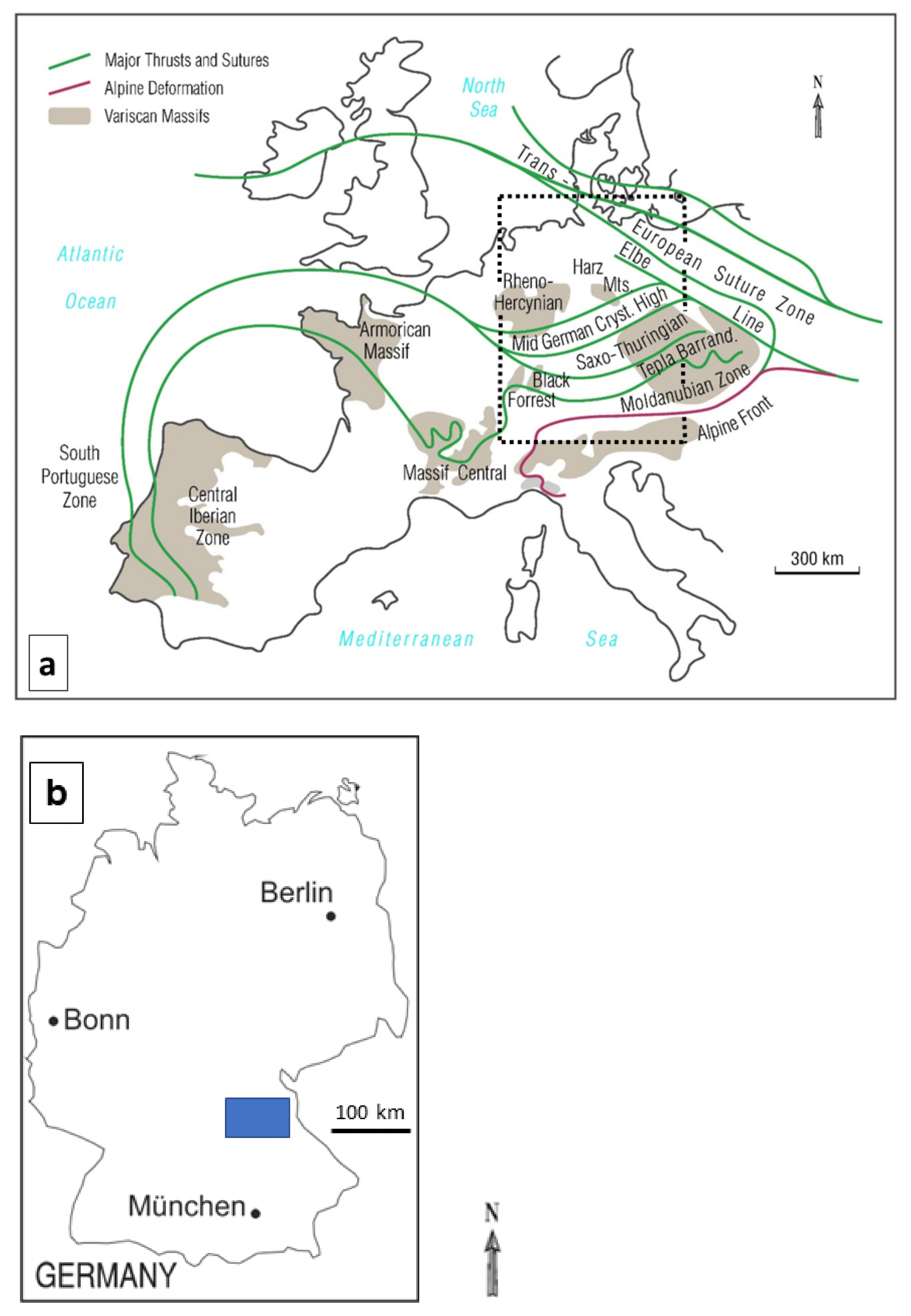
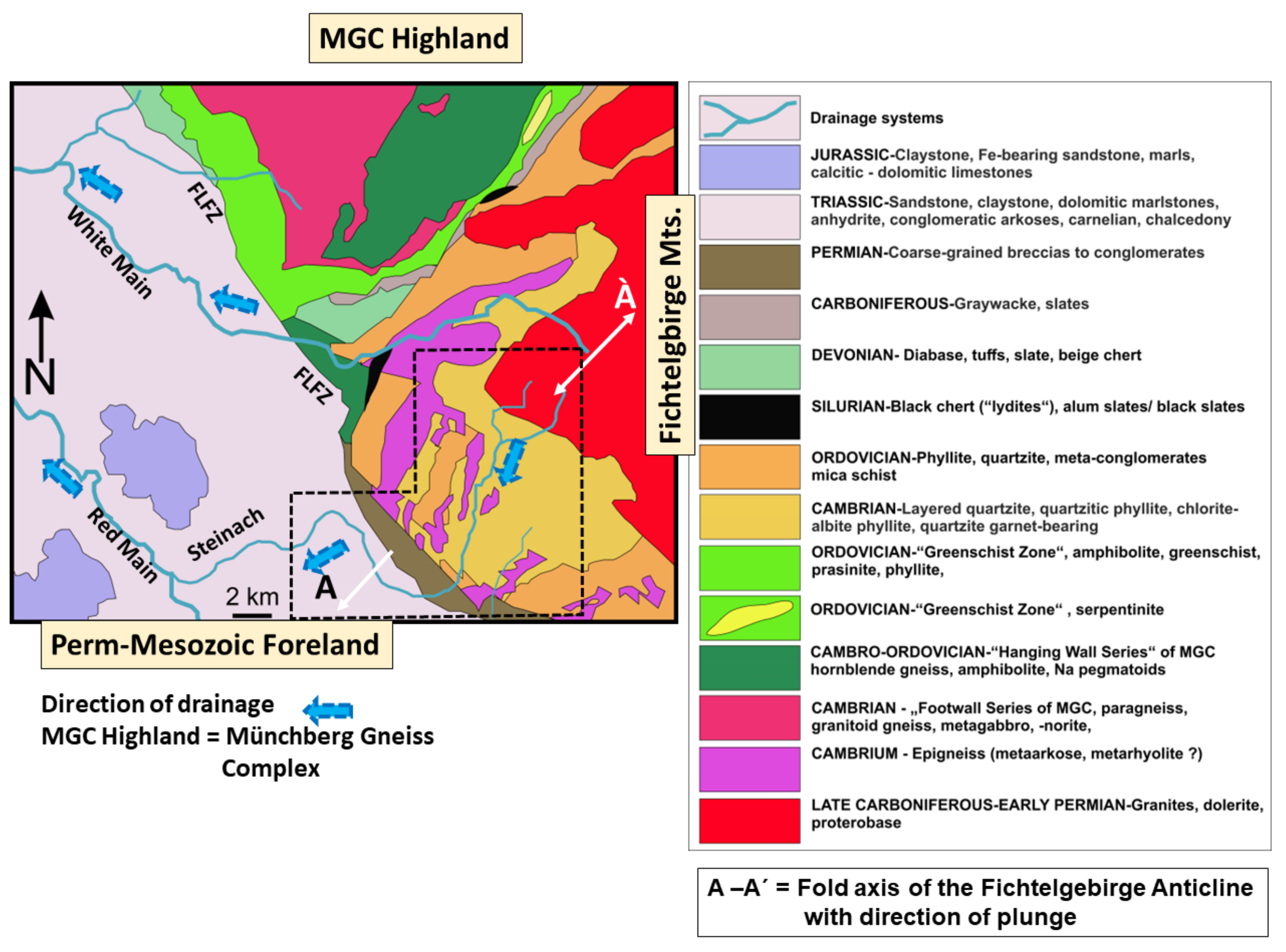
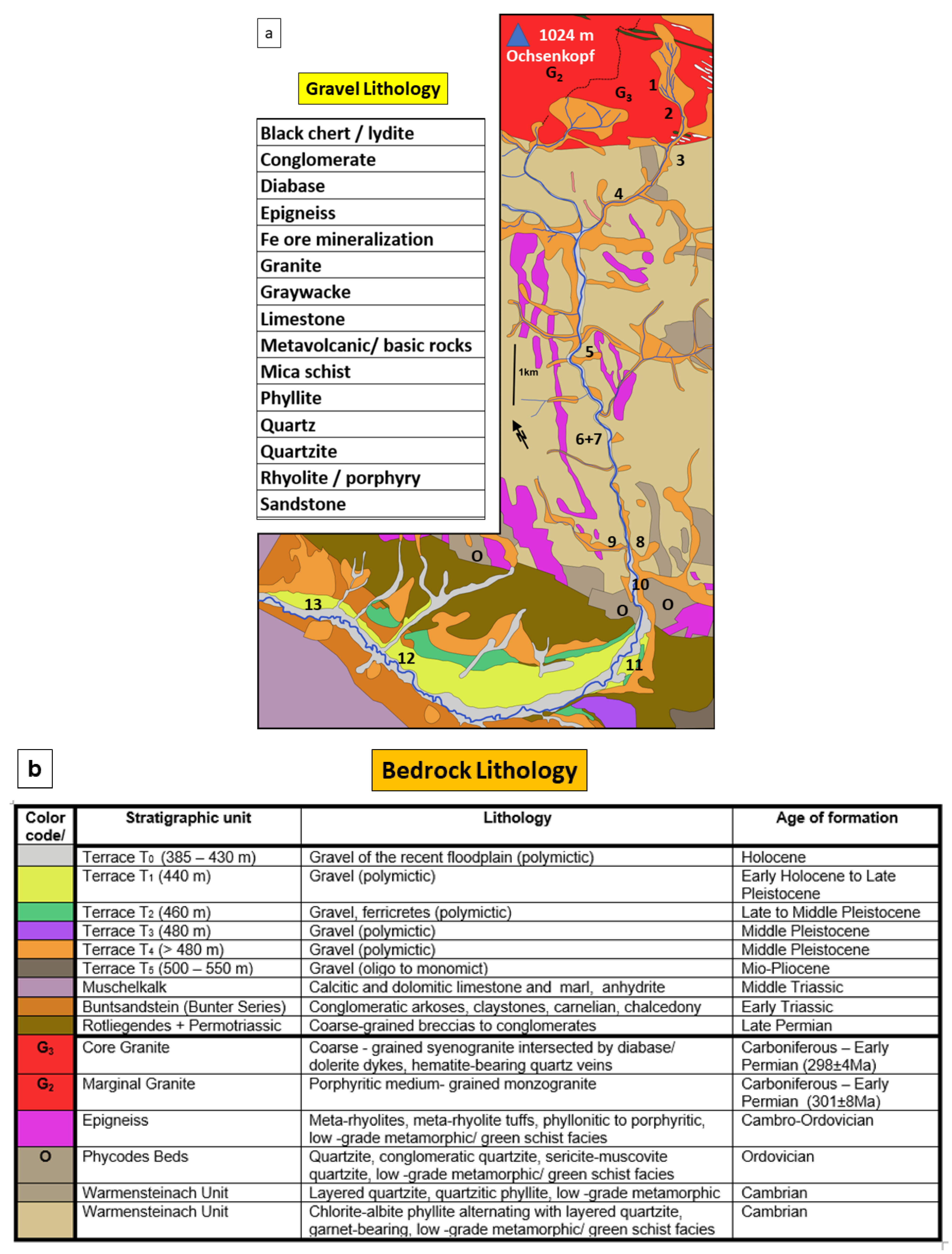
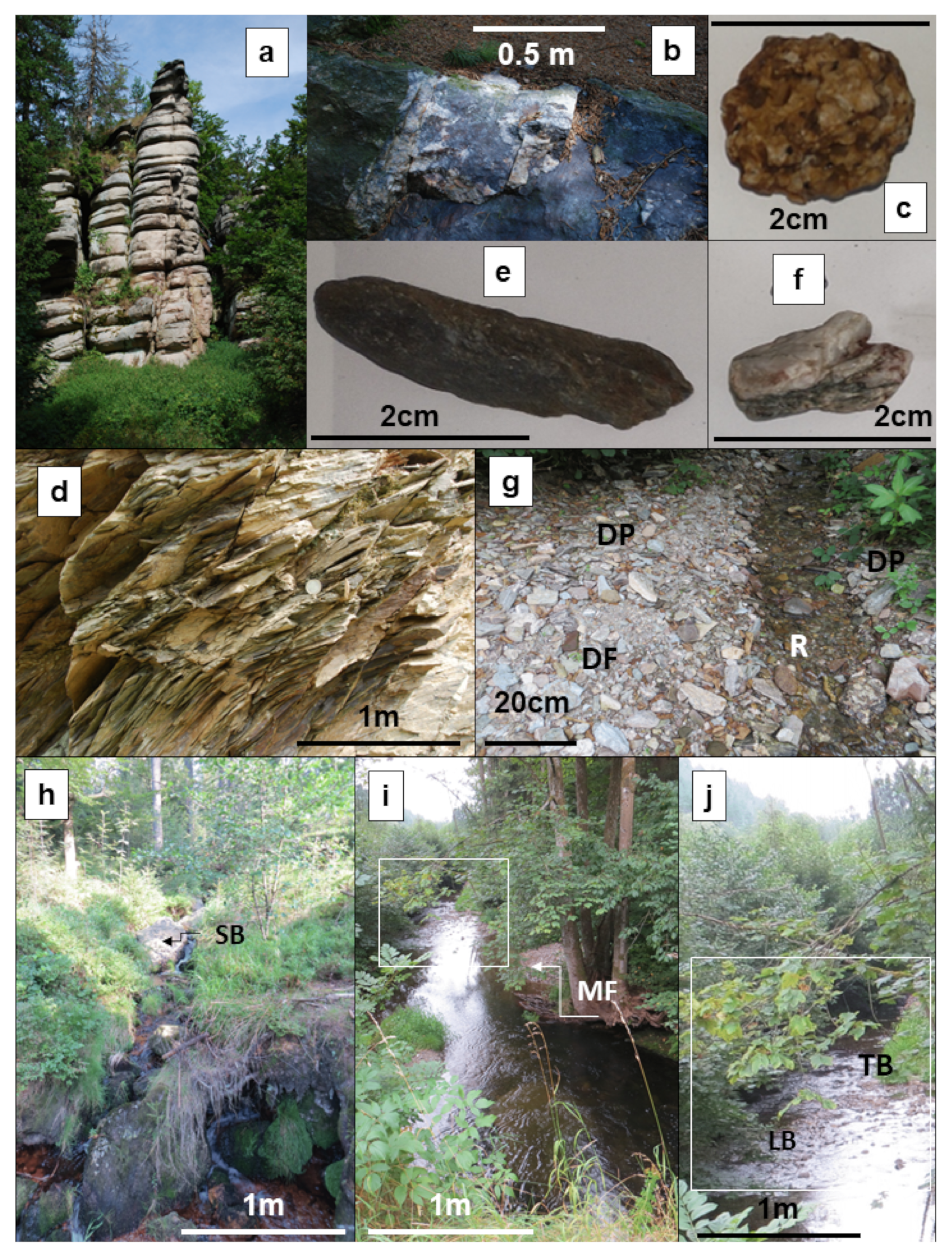

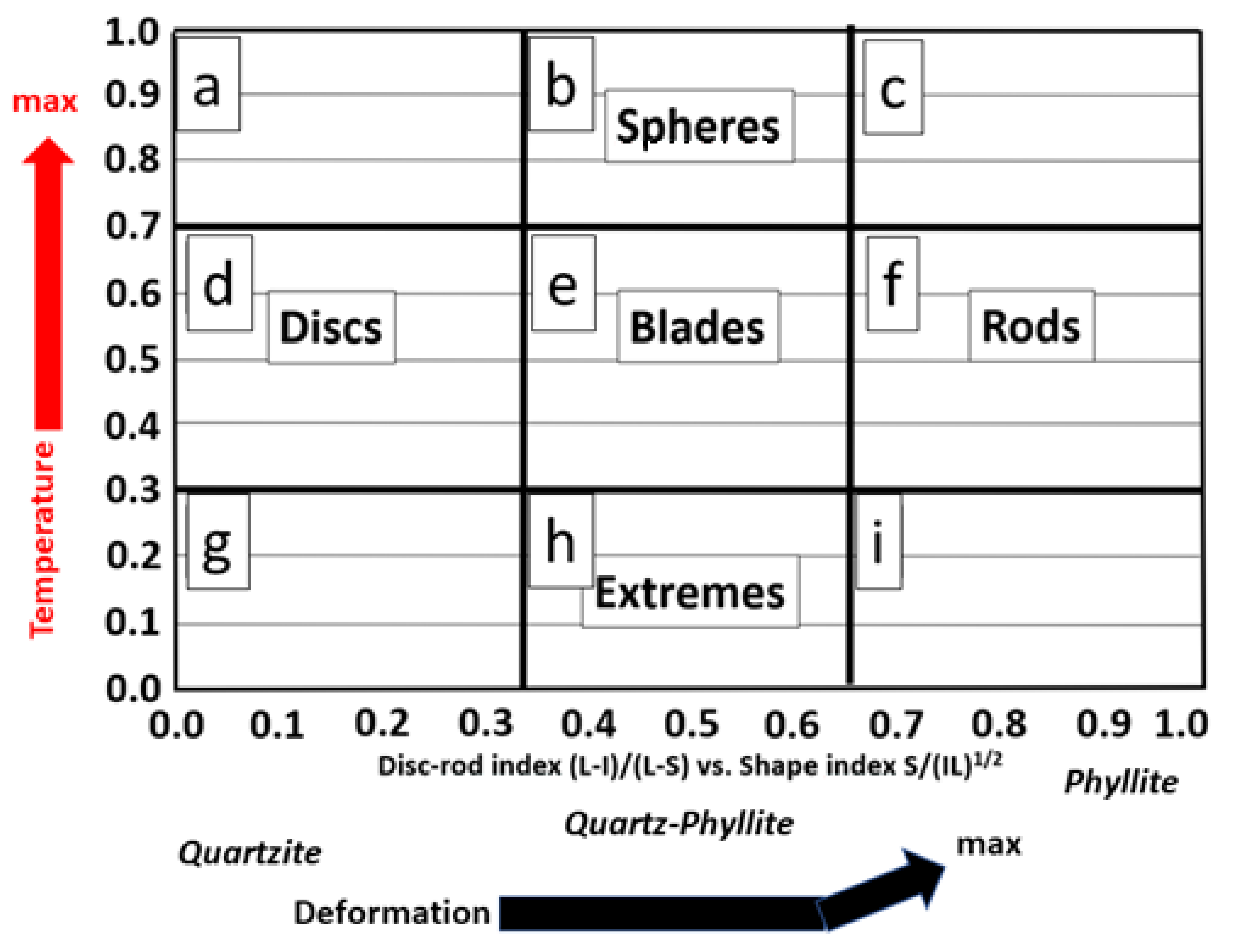
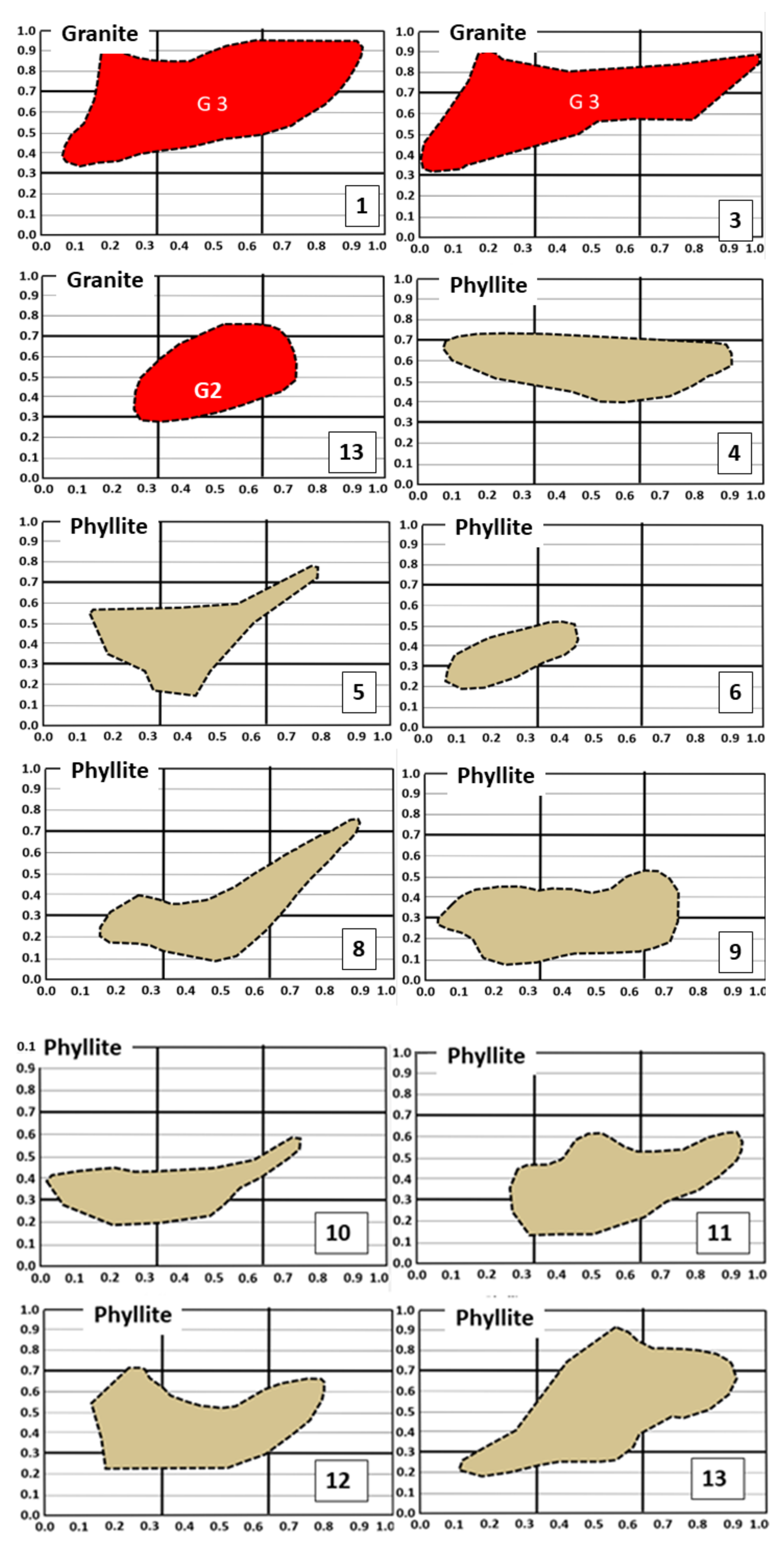

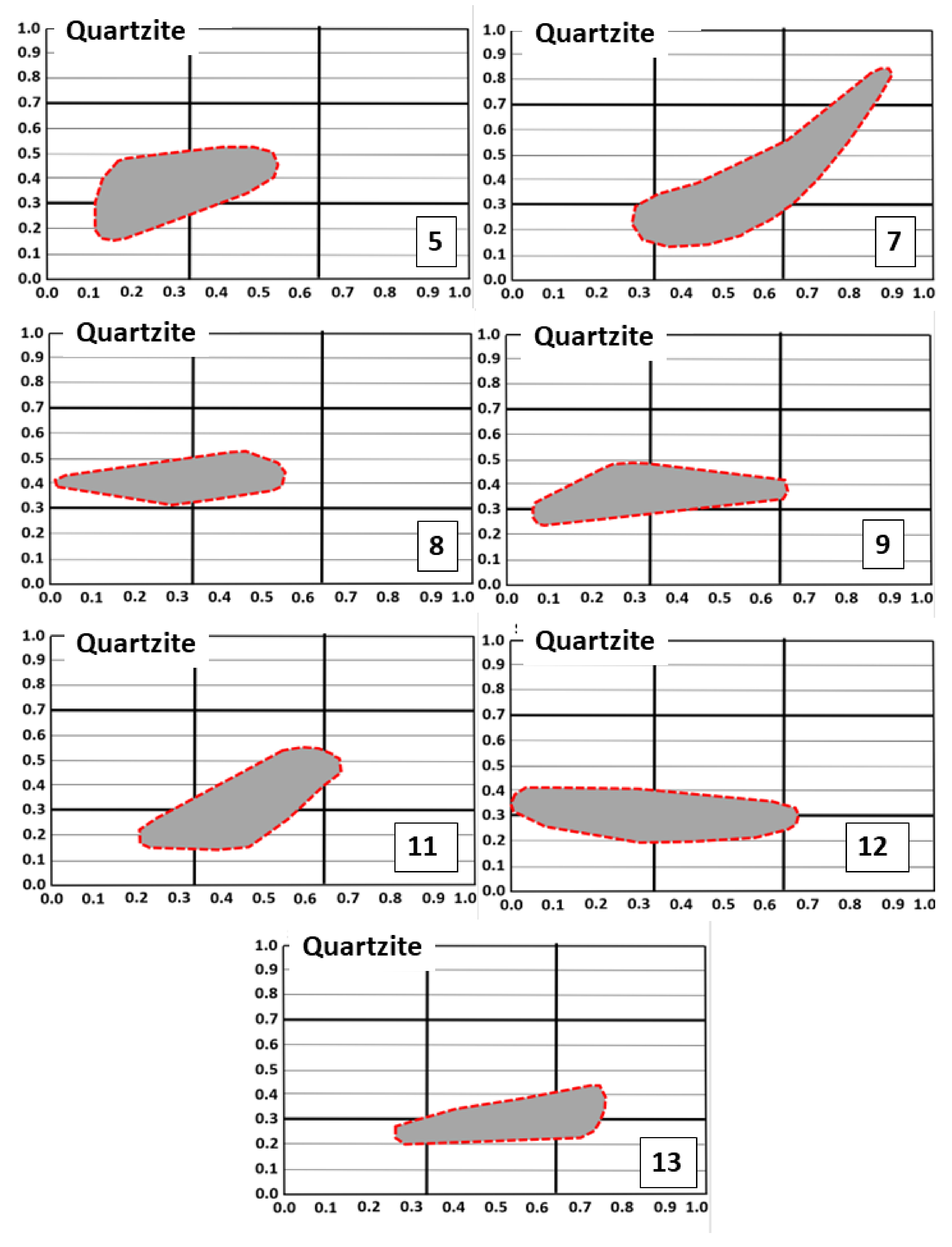

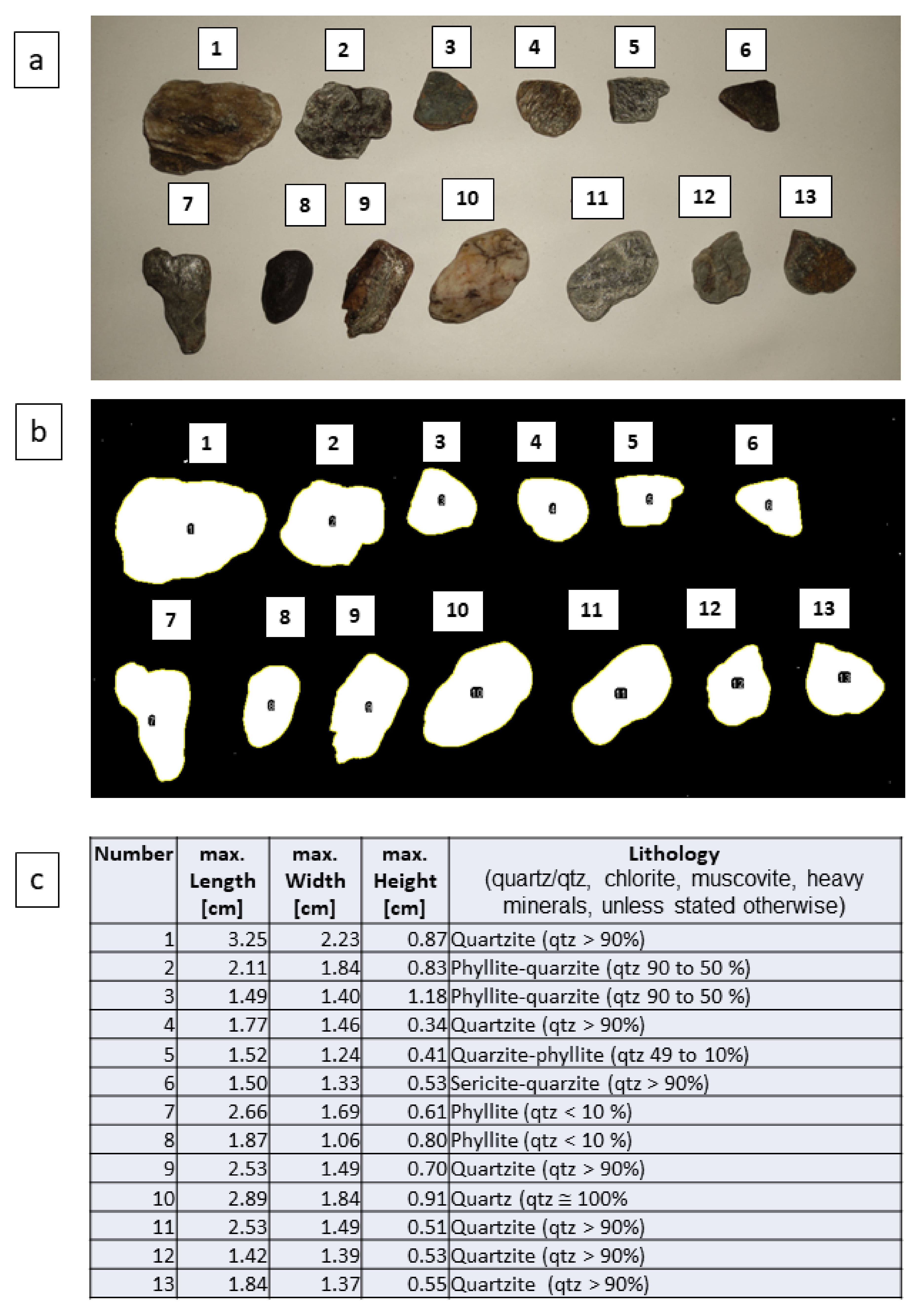
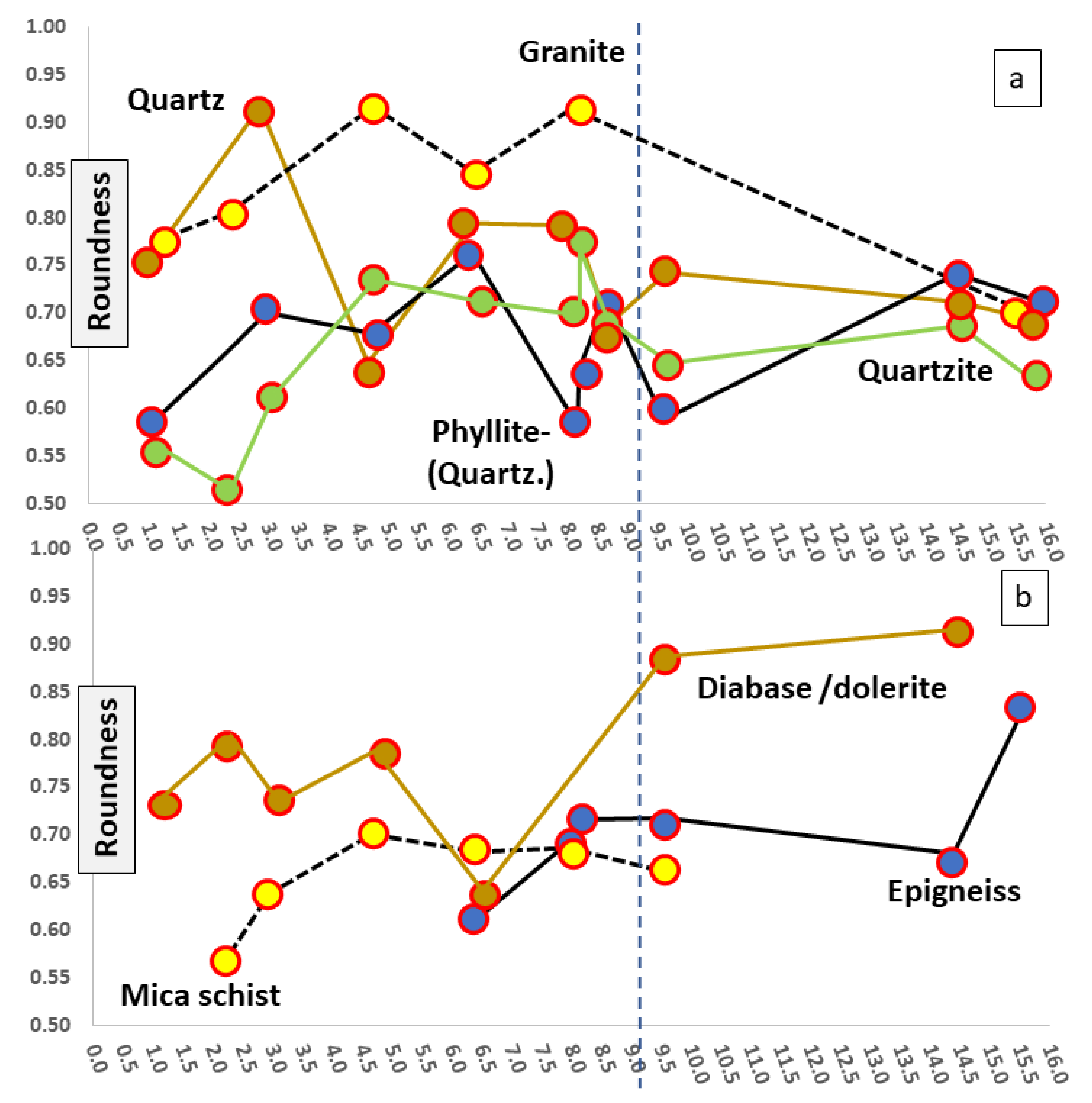
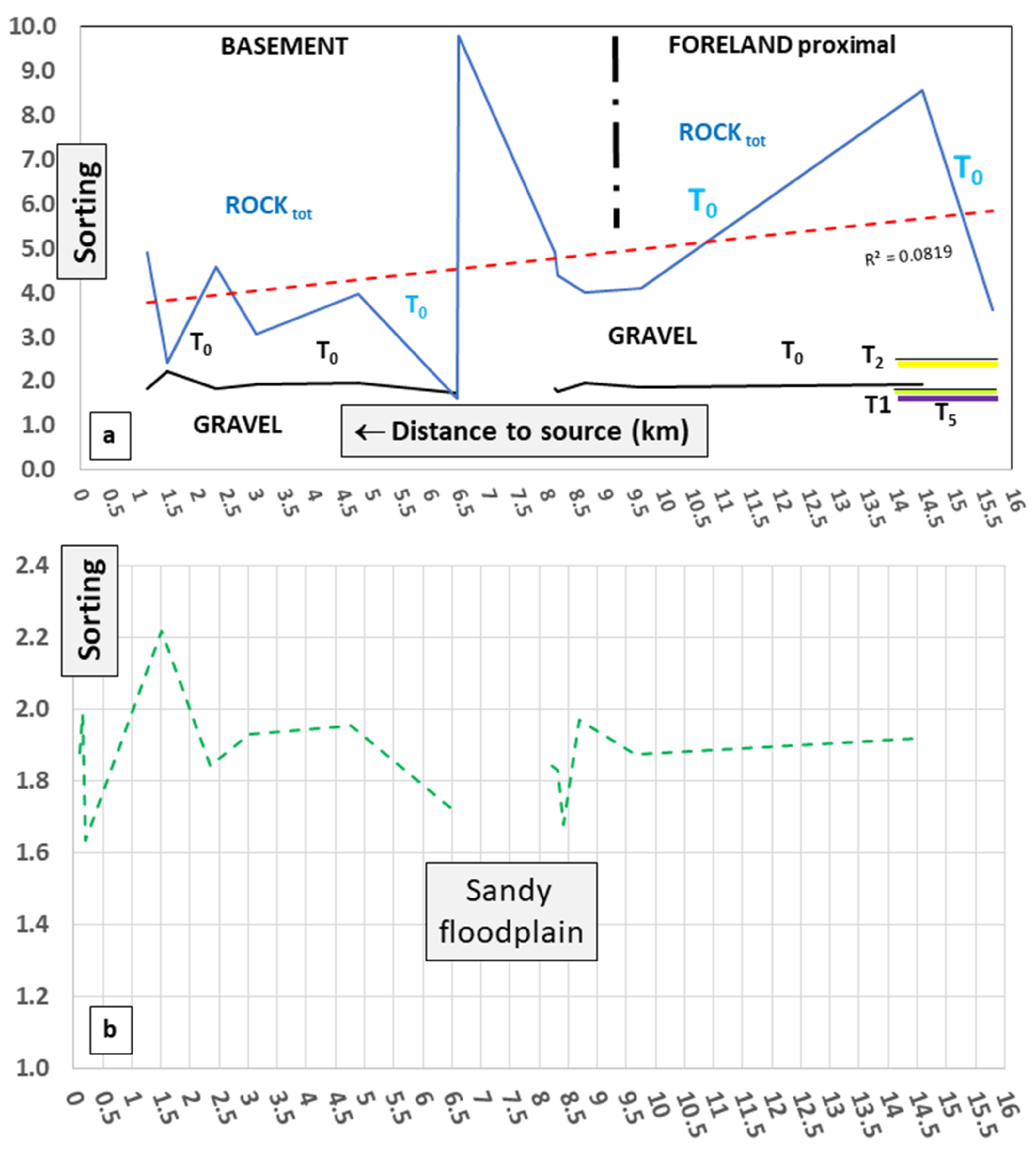
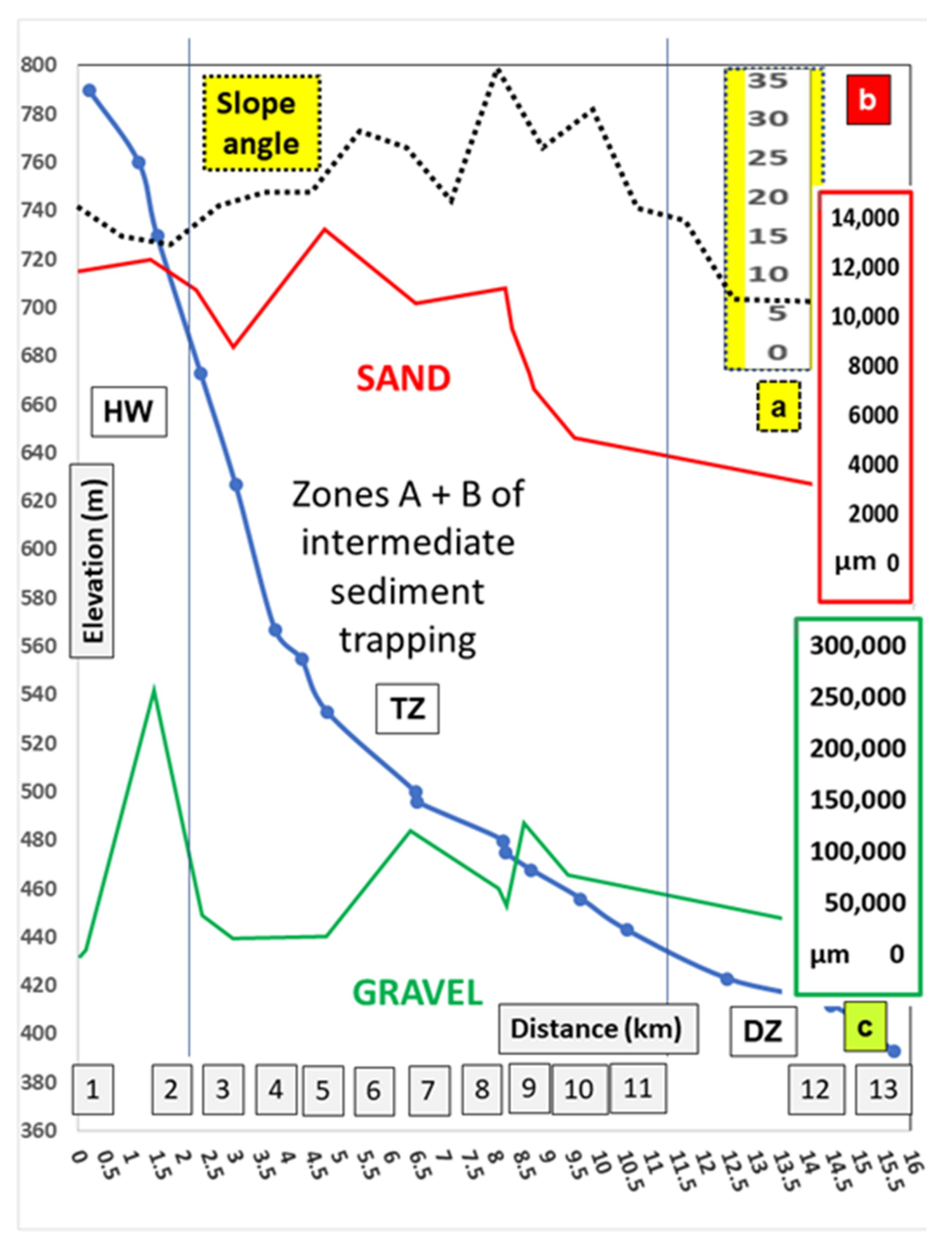
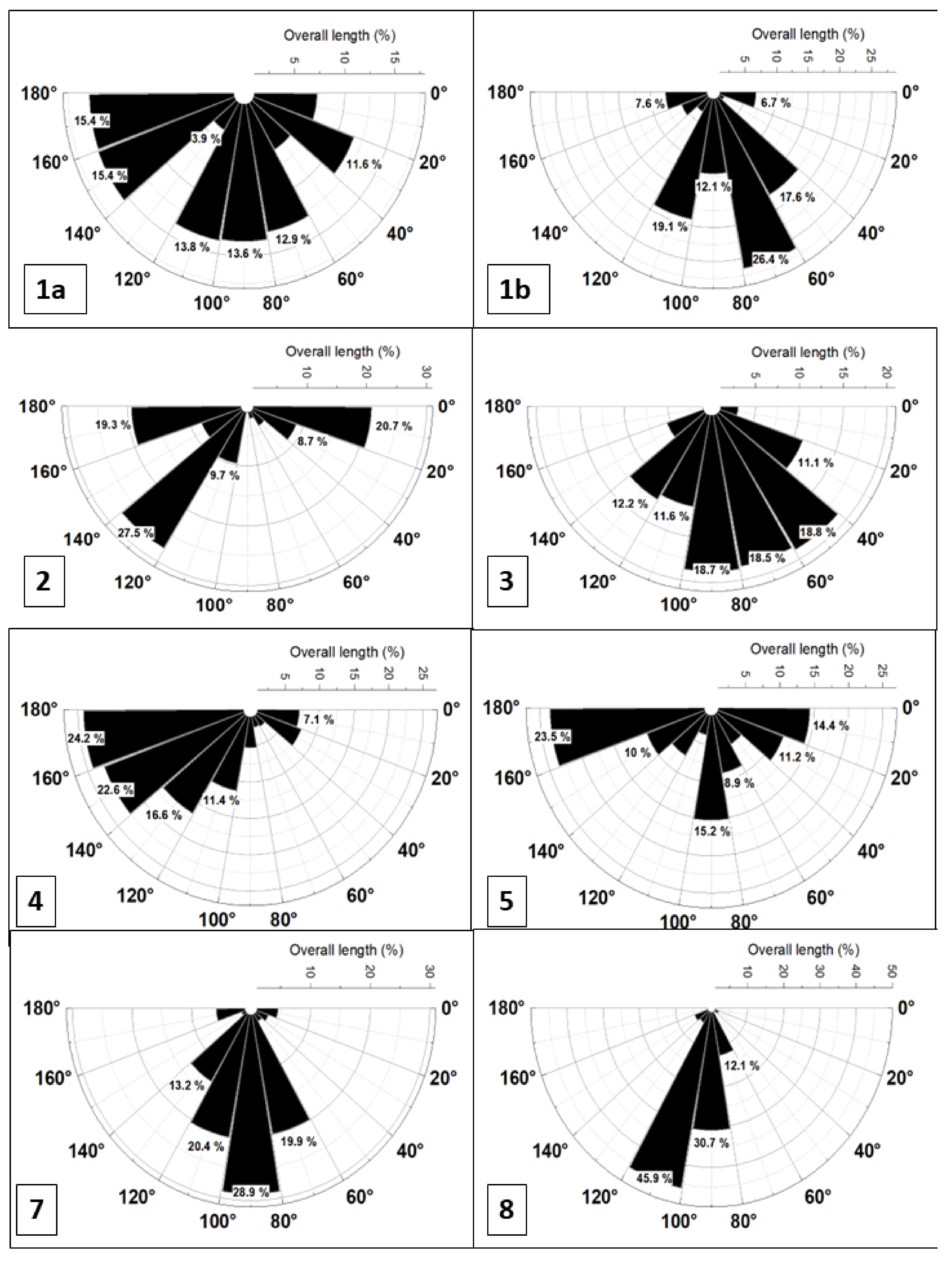
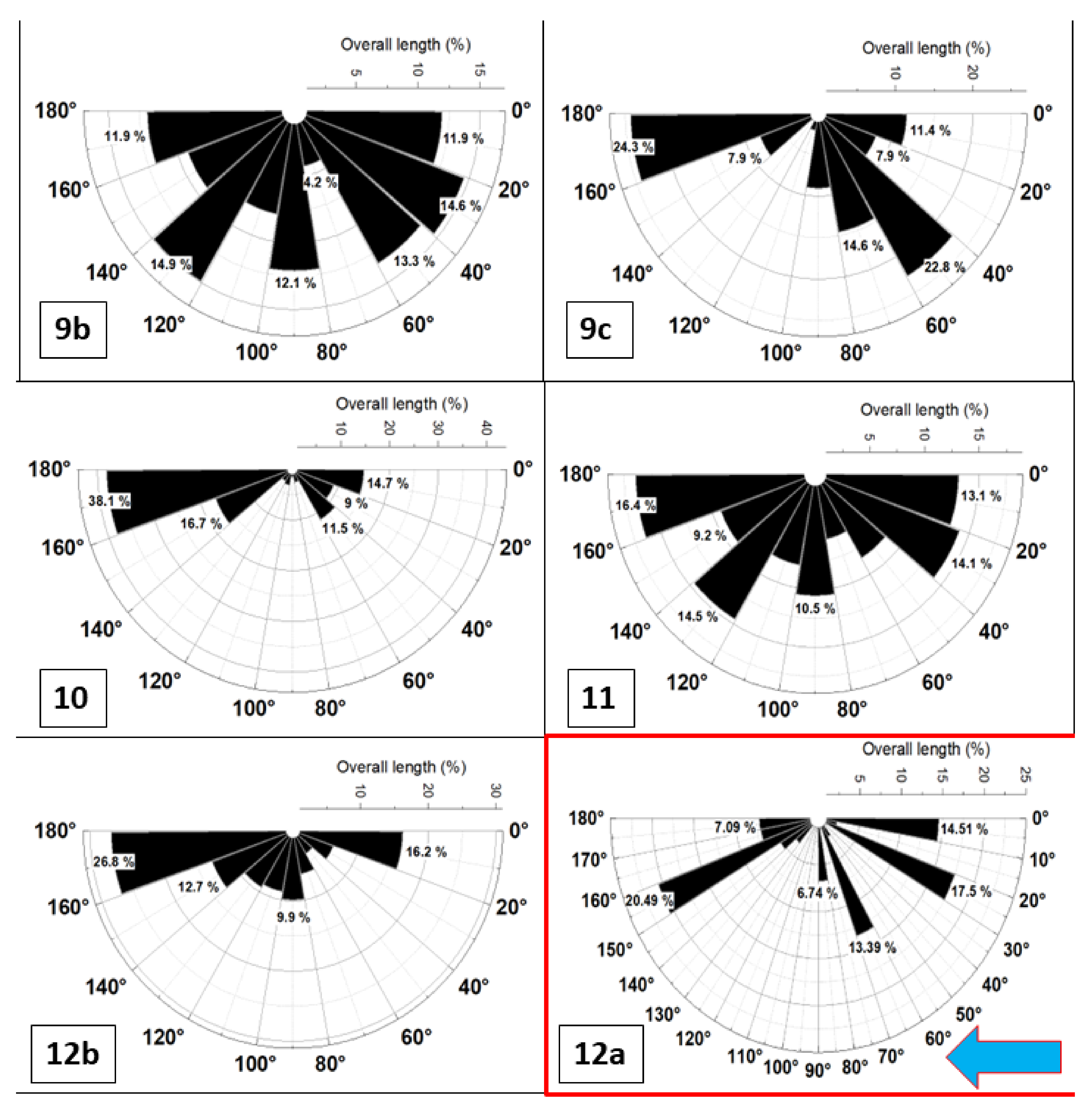
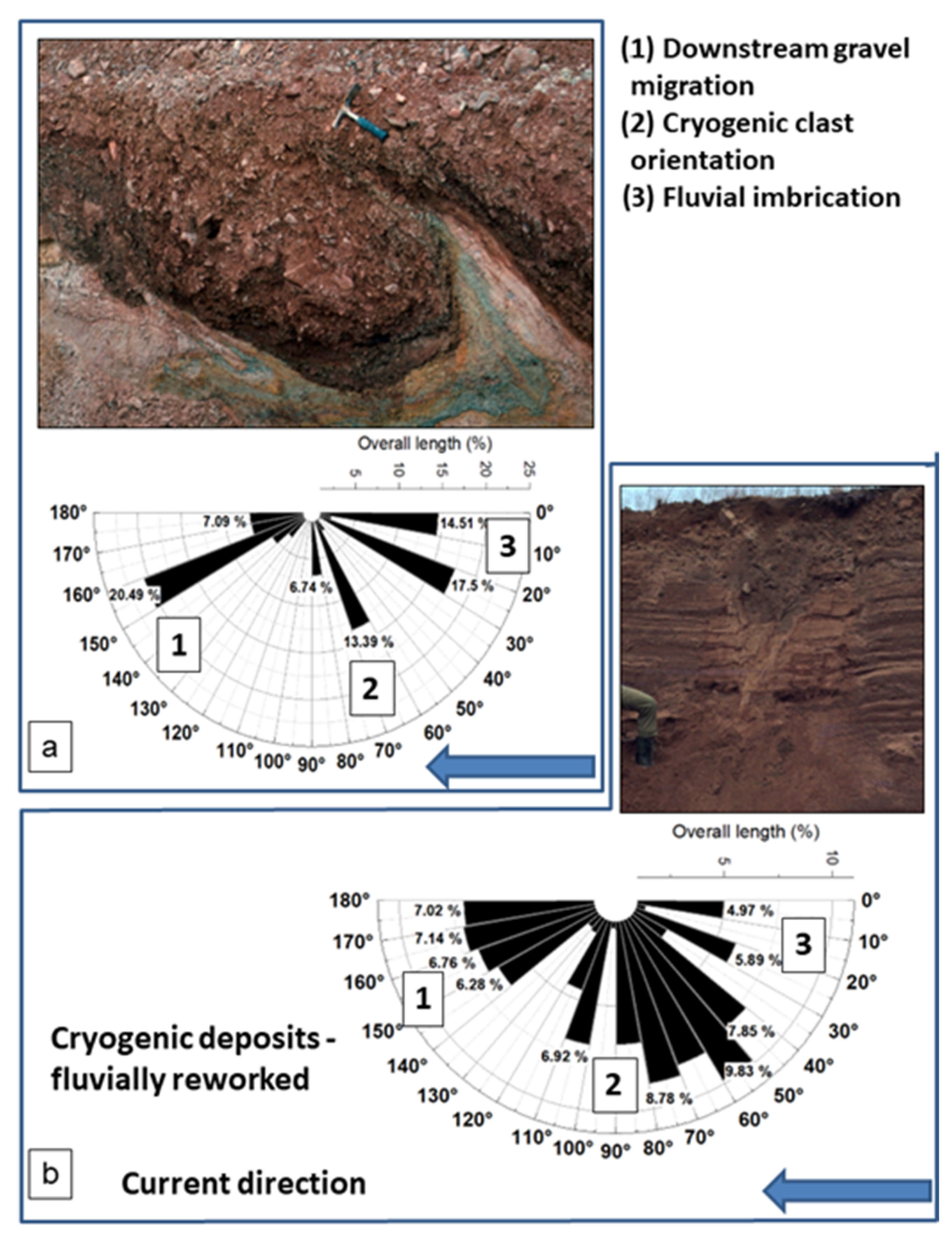
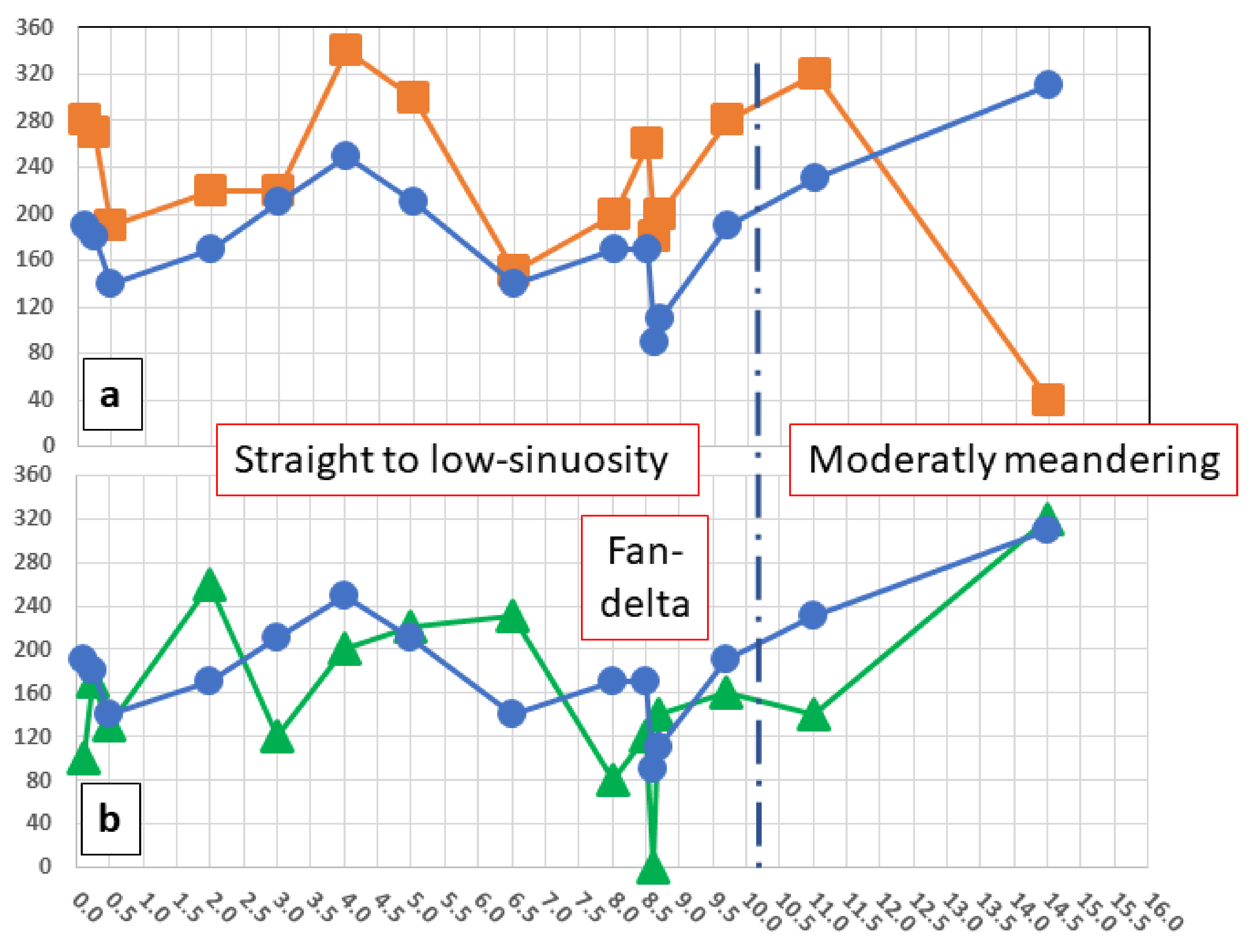
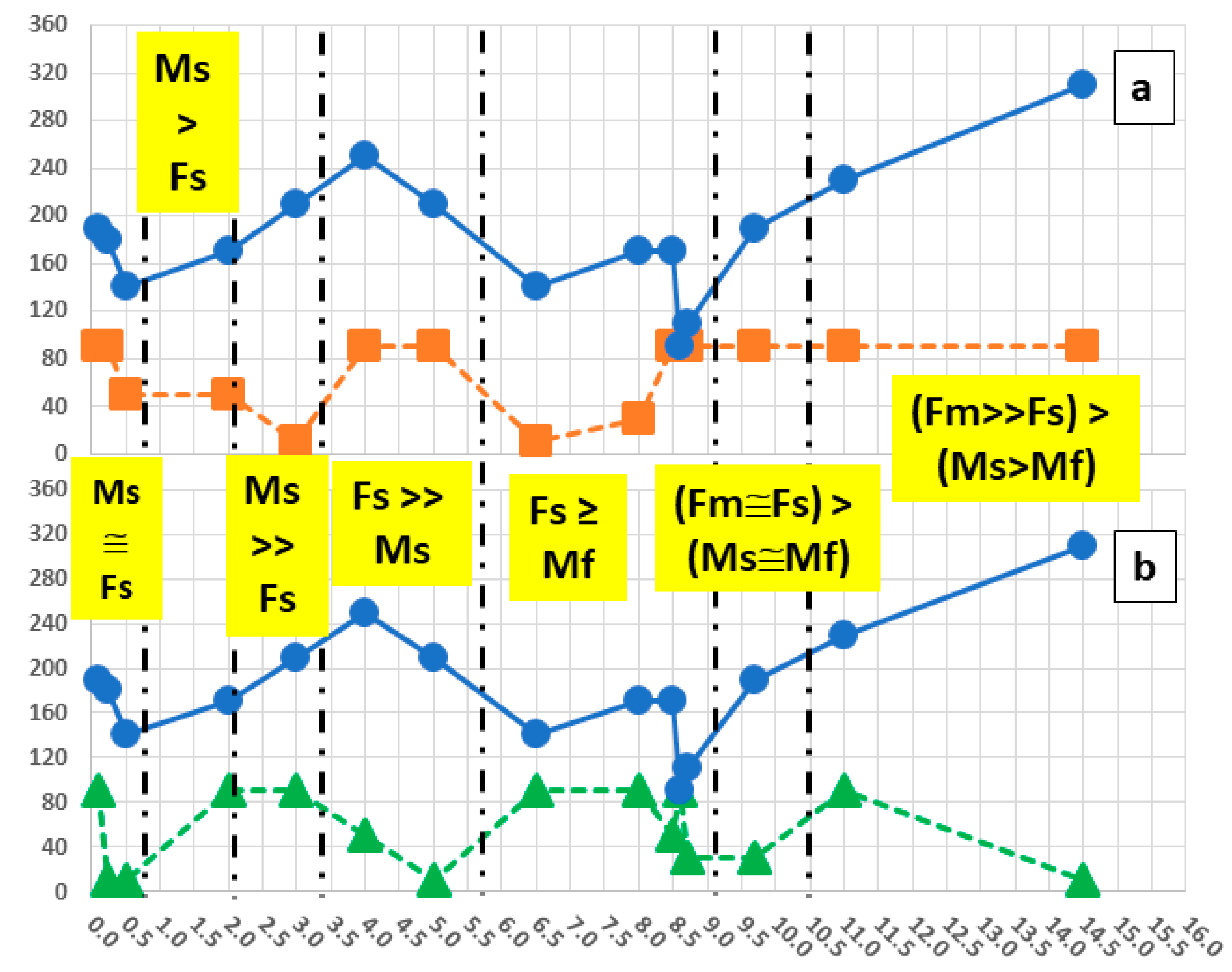
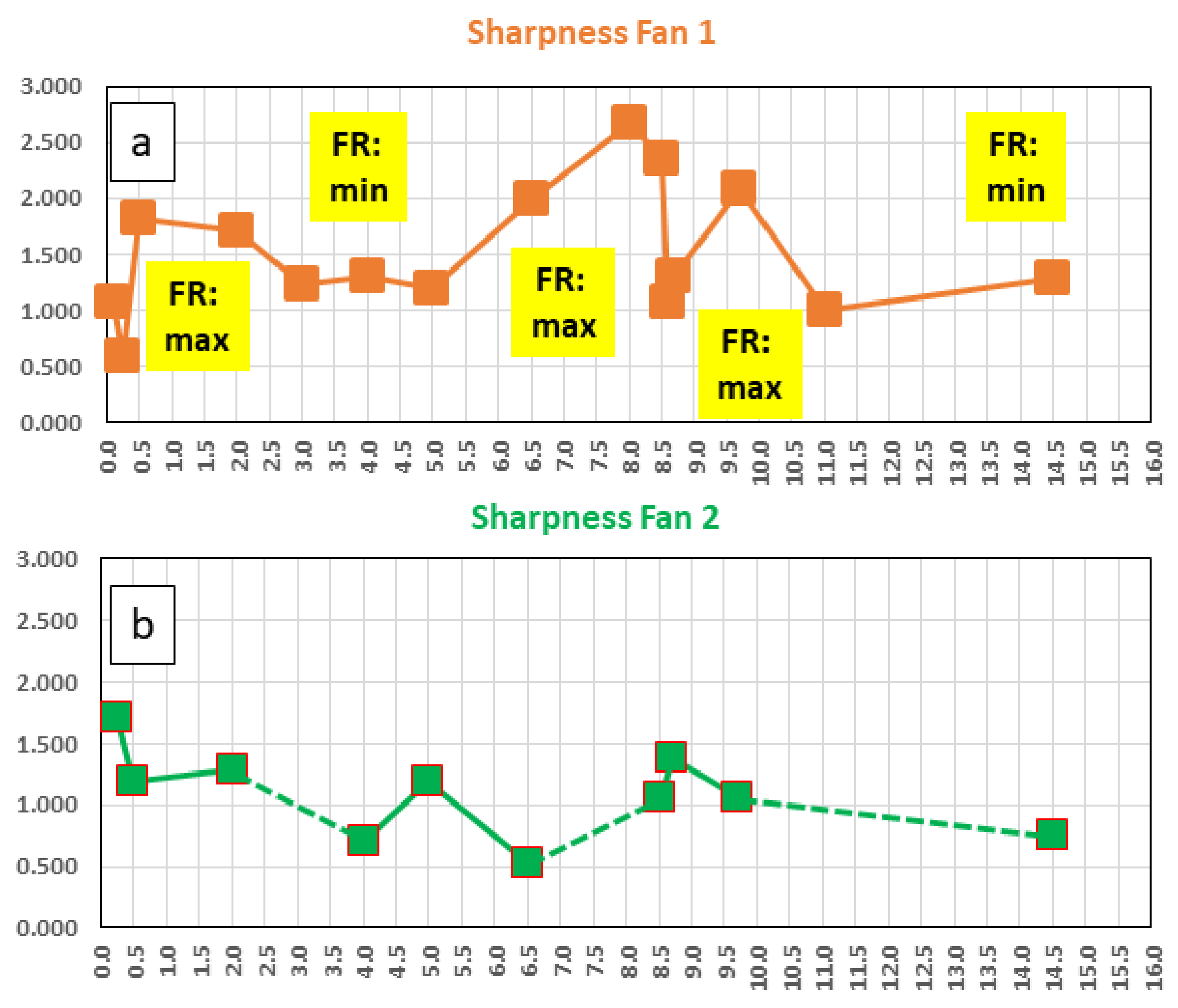
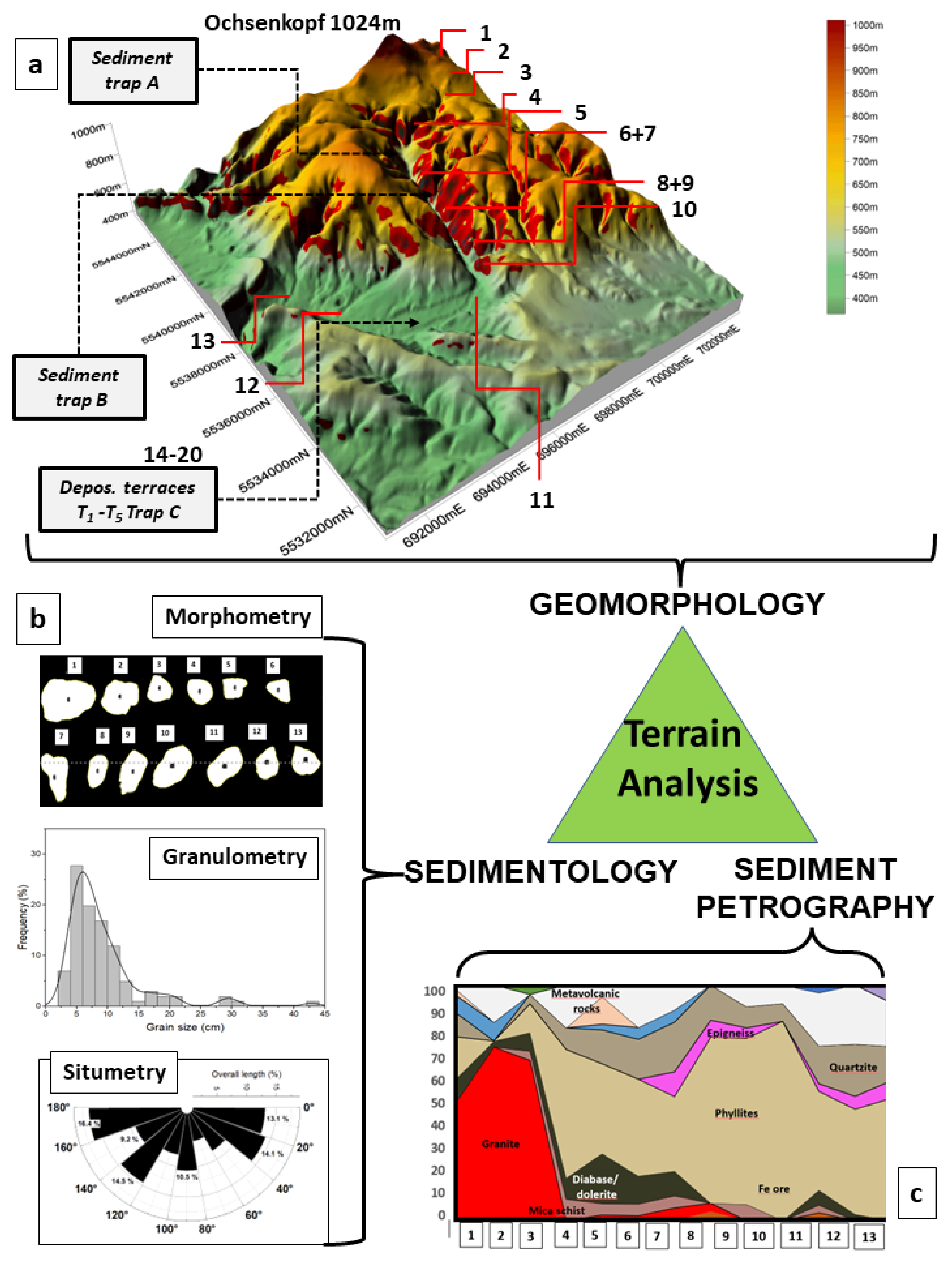
| Basement < 10 km | Foreland < 20 km | Foreland < 50 km | Origin and Occurrence | |
|---|---|---|---|---|
| Limestone | Triassic sulfate-bearing calcareous rocks of the “Weidenberg Bowl” | |||
| Carbonate gangue | Carbonate-bearing vein-type deposits | |||
| Fe mineralization | Supergene alteration, fluctuating ground water table | |||
| Ba-F ore mineralization | Barite-ankerite/siderite vein-type deposits -upstream of site 5 to site 10 | |||
| Quartz aggregates | Granites, metapsammites, vein-quartz with/without hematite | |||
| Chert (black “lydite”) | Silurian to Early Devonian marine biogenetic sediments (low to non-metamorphic) | |||
| Silcrete, “carnelian | Early Triassic paleosols | |||
| Quartzite | Low grade metamorphic sandstones-metapelites of the country rocks of the Late Paleozoic granites | |||
| Sandston–conglomerate | Permian-Lower Triassic red beds foreland basin | |||
| Graywacke | Impure sandstone of Early Paleozoic age (low to non-metamorphic) | |||
| Phyllite | Low grade metamorphic claystones-metapelites of the country rocks of the Late Paleozoic granites | |||
| Mica schist | Phyllites of slightly higher metamorphic grade (contact metamorphic) | |||
| Granite | Late Paleozoic granites of the Fichtelgebirge domal anticline | |||
| Rhyolite-dacite | Early Permian volcanic rocks at the basement-foreland boundary | |||
| Epigneiss | Early Paleozoic low grade metamorphic meta-rhyolites or meta-arkoses | |||
| Lamprophyre-Proterobase | Basic dykes intersecting the granitic domes | |||
| Diabase | Early Paleozoic meta-basalts and metabasalt tuffs | |||
| Metavolcanic rocks | Hydrothermally altered volcanic rock manly of basic composition | |||
| Epidote-chlorite amphibolite | Low-grade basic volcanics and pyroclastic rocks-Ordovician Greenschist Zone | |||
| Serpentinite | Low-grade ultrabasic volcanics and pyroclastic rocks-Ordovician Greenschist Zone | |||
| Amphibolite | Basic volcanic rocks (medium-high grade) Ordovician Greenschist Zone, MGC Hanging Wall rocks | |||
| Mica gneiss (+ garnet) | Meta-psammopelites (medium-high grade) MGC Footwall rocks | |||
| Slags (Fe, Cu.) and processing artifacts | Historic Fe smelting and waste from ceramic industry (glass) |
| Lithology of Sediment Grain | Area | Circularity | Aspect Ratio | Roundness | Solidity |
|---|---|---|---|---|---|
| Granite (in places pegmatitic) | 12,600 | 0.774 | 1.241 | 0.819 | 0.958 |
| Metavolcanic rocks (basic) | 5165 | 0.748 | 1.314 | 0.792 | 0.948 |
| Diabase plus “Proterobase” (diabase/dolerite in dikes) | 11,218 | 0.783 | 1.322 | 0.781 | 0.961 |
| Quartz aggregates (in places with relic phyllite fragments), quartz monomineralic, red-pinkish (e.g., carnelian, jasper), milky vein quartz | 8557 | 0.772 | 1.401 | 0.738 | 0.954 |
| Mud clasts | 3164 | 0.721 | 1.388 | 0.736 | 0.914 |
| Graywacke | 11,166 | 0.748 | 1.378 | 0.734 | 0.947 |
| Epizonal gneiss (“Epigneiss”) | 8911 | 0.805 | 1.43 | 0.713 | 0.971 |
| Mica schist | 9201 | 0.798 | 1.529 | 0.674 | 0.972 |
| Phyllite, phyllite with remnants of quartzite, phyllite sheared (phyllonite) | 10,316 | 0.773 | 1.557 | 0.673 | 0.964 |
| Fault breccia | 2371 | 0.773 | 1.508 | 0.663 | 0.947 |
| Quartzite, quartzite-phyllite, quartzite intergrown with remnants of phyllitic aggregates, sericite quartzite, quartzite with trace fossils “Phycodes Quarzite”, quartzite + ferricretes | 9404 | 0.748 | 1.622 | 0.658 | 0.953 |
| Conglomerate | 12,363 | 0.746 | 1.564 | 0.639 | 0.951 |
| Ferricretes | 7225 | 0.722 | 1.801 | 0.621 | 0.946 |
| Sandstone | 5769 | 0.753 | 1.67 | 0.599 | 0.969 |
| Limestone calcitic to dolomitic | 4814 | 0.699 | 2.069 | 0.489 | 0.946 |
| Calcite aggregates | 14,875 | 0.648 | 2.243 | 0.446 | 0.939 |
| Key Processes and Targets | Granulometry | Morphometry | Situmetry |
|---|---|---|---|
| Knickpoints and change of the (paleo)gradient | 3 | 1 | 1 |
| Sediment sorting | 2 | 1 | 0.5 |
| Sediment traps (whirlpool, flood plain traps) | 1.5 | 1 | 2 |
| Tectovariance of the parent rocks | 2 | 2 | 1 |
| Lithovariance of the parent and source rocks (provenance analysis) | 1.5 | 3 | 1 |
| Placer discoveries | 1 | 2 | 2 |
| Identification of vulnerable landforms and areas prone to geohazards | 2 | 2 | 2 |
| Weathering | 2 | 3 | 2 |
| Hydrodynamic processes | 1 | 1 | 3 |
| Diagnosis of mass wasting, fluvial, and cryogenic land-forming processes | 0.5 | 1 | 3 |
Publisher’s Note: MDPI stays neutral with regard to jurisdictional claims in published maps and institutional affiliations. |
© 2022 by the authors. Licensee MDPI, Basel, Switzerland. This article is an open access article distributed under the terms and conditions of the Creative Commons Attribution (CC BY) license (https://creativecommons.org/licenses/by/4.0/).
Share and Cite
Dill, H.G.; Buzatu, A.; Kleyer, C.; Balaban, S.-I.; Pöllmann, H.; Füssel, M. A Natural GMS Laboratory (Granulometry-Morphometry-Situmetry): Geomorphological-Sedimentological-Mineralogical Terrain Analysis Linked to Coarse-Grained Siliciclastic Sediments at the Basement-Foreland Boundary (SE Germany). Minerals 2022, 12, 1118. https://doi.org/10.3390/min12091118
Dill HG, Buzatu A, Kleyer C, Balaban S-I, Pöllmann H, Füssel M. A Natural GMS Laboratory (Granulometry-Morphometry-Situmetry): Geomorphological-Sedimentological-Mineralogical Terrain Analysis Linked to Coarse-Grained Siliciclastic Sediments at the Basement-Foreland Boundary (SE Germany). Minerals. 2022; 12(9):1118. https://doi.org/10.3390/min12091118
Chicago/Turabian StyleDill, Harald G., Andrei Buzatu, Christopher Kleyer, Sorin-Ionut Balaban, Herbert Pöllmann, and Martin Füssel. 2022. "A Natural GMS Laboratory (Granulometry-Morphometry-Situmetry): Geomorphological-Sedimentological-Mineralogical Terrain Analysis Linked to Coarse-Grained Siliciclastic Sediments at the Basement-Foreland Boundary (SE Germany)" Minerals 12, no. 9: 1118. https://doi.org/10.3390/min12091118
APA StyleDill, H. G., Buzatu, A., Kleyer, C., Balaban, S.-I., Pöllmann, H., & Füssel, M. (2022). A Natural GMS Laboratory (Granulometry-Morphometry-Situmetry): Geomorphological-Sedimentological-Mineralogical Terrain Analysis Linked to Coarse-Grained Siliciclastic Sediments at the Basement-Foreland Boundary (SE Germany). Minerals, 12(9), 1118. https://doi.org/10.3390/min12091118







